National Geographic content straight to your inbox—sign up for our popular newsletters here


How to see India's Golden Triangle by train
Taking in myriad forms of architecture, the Golden Triangle route between Delhi, Agra and Jaipur is a journey into India’s history, craftsmanship and culture. Here’s what you need to know to navigate the three-stop itinerary by rail.
Exploring the so-called ‘Golden Triangle’ of Delhi, Jaipur and Agra — home to the Taj Mahal — is an ideal way for first-time visitors to India to ease into their travels. These three major cities in the country’s north can be explored in as little as five days or a long as a fortnight; as well as serving up a taste of modern India, they feature all kinds of classic architecture. From Mughal forts, mausoleums and havelis to palaces, mosques and temples, the popular travel itinerary offers a headfirst dive into India’s history, craftsmanship and culture. While excellent motorways run between the cities, touring by train lets passengers peer into the nooks and crannies of the region, bringing a touch more magic to the journey.
Getting to know Delhi
India’s capital city, built and rebuilt upon the rubble of Sufi shrines and Mughal tombs, is home to bazaars, swathes of jungle and parks with bougainvillea-draped tombs. From Haveli Dharampura — a boutique hotel in a restored 19th-century mansion in the heart of Old Delhi — it’s a 10-minute walk towards the sound of hissing karahis in the food haven of Matia Mahal Bazar, where mutton burra kebabs and silk-soft roti are served at Karim’s. Lodhi Gardens is a popular spot for dawn joggers and evening amblers, while Sunder Nursery feels like a national park due to the 40 varieties of butterfly that flit between flaming gulmohar trees, ponds and flowerbeds. For a night-market experience, head to Dilli Haat, an open-air bazaar where crafts and snacks from every Indian state include Mirzapur rugs, camel-hair blankets, mirrored bedspreads and Assamese steamed fish.

Moving on to Agra
The daily Gatimaan Express, the fastest train operating in India, departs from Delhi’s Hazrat Nizamuddin station just after 8am. This service, with its wide, comfy seats and wi-fi, takes just one hour and 40 minutes to pull into Agra Cantonment station. Sipping milky coffee and snacking on cutlet sandwiches, passengers watch as the BMWs and malls of Delhi morph into bullock carts and maize fields. On arrival in Agra, you can take a taxi to the Itmad-ud-Daulah tomb, a Mughal mausoleum known as the Baby Taj, which overlooks the Yamuna River. Follow this with a wander around the gardens at Mehtab Bagh before the midday sun hits its peak. It’s typical to visit the Taj Mahal at dawn, but nothing beats the sight of the world’s most magnificent mausoleum by moonlight. For five days a month (on the night of the full moon, two nights before and two nights after), eight groups of a maximum of 50 people are granted entry between 8.30pm and 12.30am. With so few visitors, a hush falls on the grounds as the Taj basks in a blue glow.

An early morning departure for Jaipur
Dawn trains offer travellers front-row seats to the performances that they would miss by air or car. Departing Agra at 6am, the Agra Fort-Ajmer Intercity SF Express rolls west into Rajasthan as shutters fly up on shops, chaiwallahs ladle steaming yards of tea into glasses, and wet-haired schoolchildren wave from buses. In just over four hours, the fast service reaches Jaipur Junction, from where it’s a short auto-rickshaw ride into the heart of the Pink City, so named due to the unusual pigment in its sandstone palaces, houses and ramparts. Home to artisanal jewellery, the ancient art of block printing, and striking blue pottery, Jaipur is a shopper’s delight. Base yourself at the five-star Leela Palace hotel, take a tour of Amer Fort, then visit Ridhi Sidhi Textiles on Amer Road for block-printed quilts, placemats and pyjamas. For funky shirts, trousers and hats, ask for Sachi Badaya, the owner’s niece, who set up her own boutique during lockdown. Finally, stop by Ram Gopal Blue Pottery, where Garima Saini and her father Gopal make everything from chest-high urns to toothbrush holders, coasters and doorknobs. To make the most of the Indian train experience, choose the daily Ranikhet Express to return to Delhi. Leaving at around 3.30pm, the slower service allows passengers to snooze in a berth, wander the aisles and bask on the steps in the warmth of the evening sun as the train winds through the desert.
Published in the March 2023 issue of National Geographic Traveller (UK)
Sign up to our newsletter and follow us on social media:
Facebook | Instagram | Twitter
Introducing Nat Geo Kids Book Bundle!
Related topics.
- TRANSPORTATION
- HISTORY AND CIVILIZATION
- CULTURAL TOURISM
- MODERN HISTORY
You May Also Like

The big trip: how to plan the ultimate Silk Road adventure through Central Asia

An overnight adventure travelling from Sofia to Istanbul by train

A guide to Jaipur's craft scene, from Rajasthani block printing to marble carving

How to plan a weekend in South Moravia, Czech wine country

Bunkers, beats & adventure: how to spend a perfect weekend in Bosnia & Herzegovina
- Perpetual Planet
- Environment
History & Culture
- History & Culture
- History Magazine
- Mind, Body, Wonder
- Paid Content
- Adventures Everywhere
- Terms of Use
- Privacy Policy
- Your US State Privacy Rights
- Children's Online Privacy Policy
- Interest-Based Ads
- About Nielsen Measurement
- Do Not Sell or Share My Personal Information
- Nat Geo Home
- Attend a Live Event
- Book a Trip
- Inspire Your Kids
- Shop Nat Geo
- Visit the D.C. Museum
- Learn About Our Impact
- Support Our Mission
- Advertise With Us
- Customer Service
- Renew Subscription
- Manage Your Subscription
- Work at Nat Geo
- Sign Up for Our Newsletters
- Contribute to Protect the Planet
Copyright © 1996-2015 National Geographic Society Copyright © 2015-2024 National Geographic Partners, LLC. All rights reserved

The Ultimate Guide to India’s Golden Triangle
The Golden Triangle is a popular tourist circuit in Northern India.
In fact, it’s the most popular part of the country for visitors. It encompasses the triangular region between New Delhi, Agra, and Jaipur, with every city located around 125 miles from the others.
These days, the Golden Triangle receives a bit of a mixed write-up and before I touched down in Delhi, I was fully expecting to be disappointed by my week there.
I’m not a fan of tourist-filled destinations, and I’d read plenty of articles concentrating on how you should skip over the Golden Triangle entirely. So many people said that visiting would mean contributing to overtourism and that the true jewels of India lay outside this area.
Usually, that would be enough to have me running for the mountains, but, well, can you imagine travelling to India and not seeing the Taj Mahal? I couldn’t, so I planned for a week in the Golden Triangle and held my breath, wondering if it would be a decision I’d come to regret.
To my great surprise, I loved my time here!
I arrived with low expectations, yet adored every second I spent exploring these three wonderful cities. Today, I’m excited to share why I fell in love with this region of India and how you can make sure you have just as wonderful a trip there.
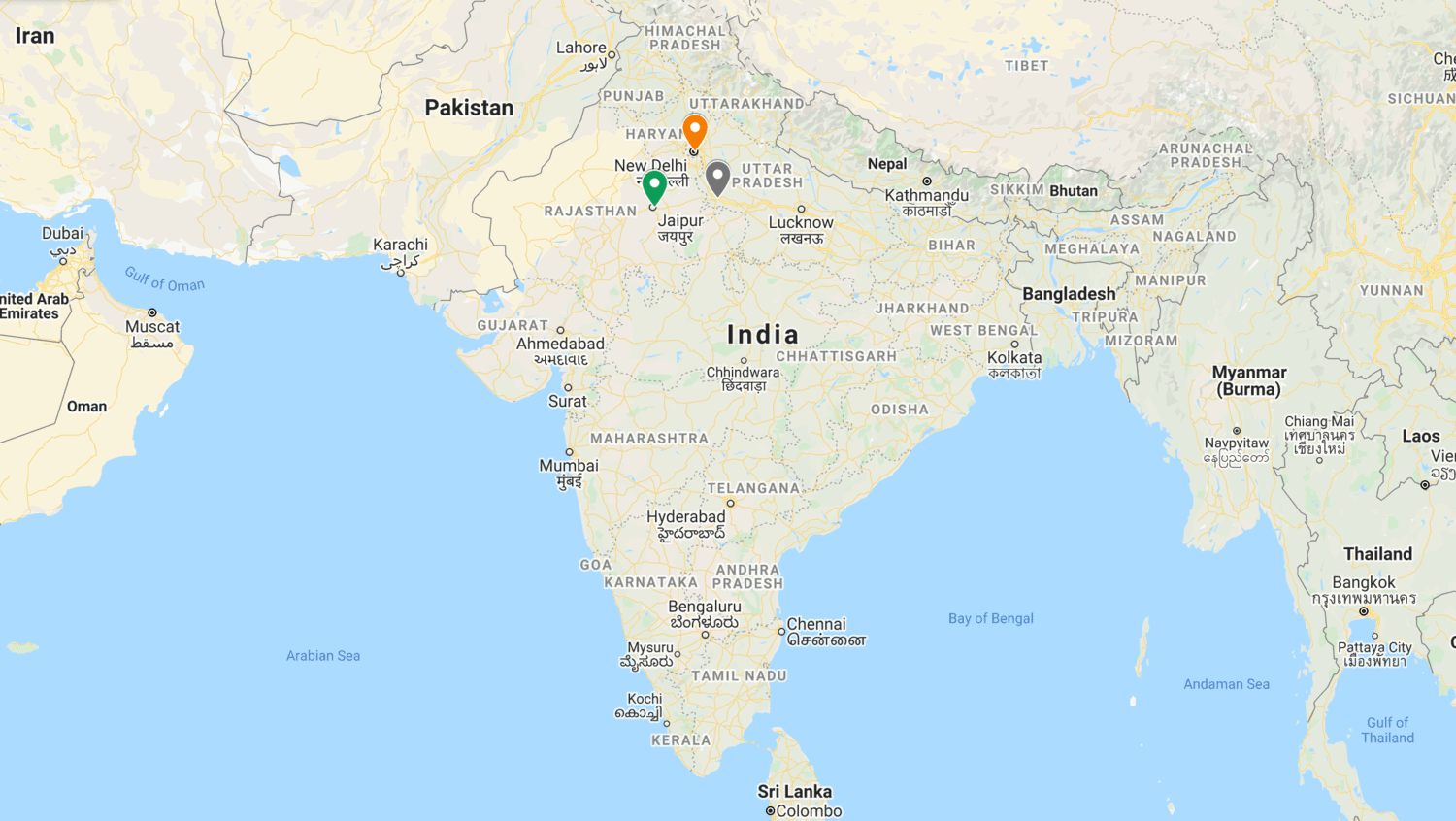
Where is the Golden Triangle?
As you can see from the map, the Golden Triangle comprises an almost equilateral triangle, with New Delhi at the top, Agra on the bottom-right, and Jaipur on the bottom-left. The distance between New Delhi and Agra is 233 km, Agra and Jaipur is 237 km, and Jaipur and Delhi is 273 km.
Most travellers fly into New Delhi, travel next to Agra, and then finish up in Jaipur, which is exactly what I chose to do. From that point, you can either venture back into New Delhi to leave the country, or continue travelling. The most popular next destinations for first-time visitors to India include the region of Rajasthan, as well as Mumbai, Varanasi, and Goa.
It doesn’t really matter which direction you travel around the Golden Triangle, as there are so many transportation options to choose from between each place.
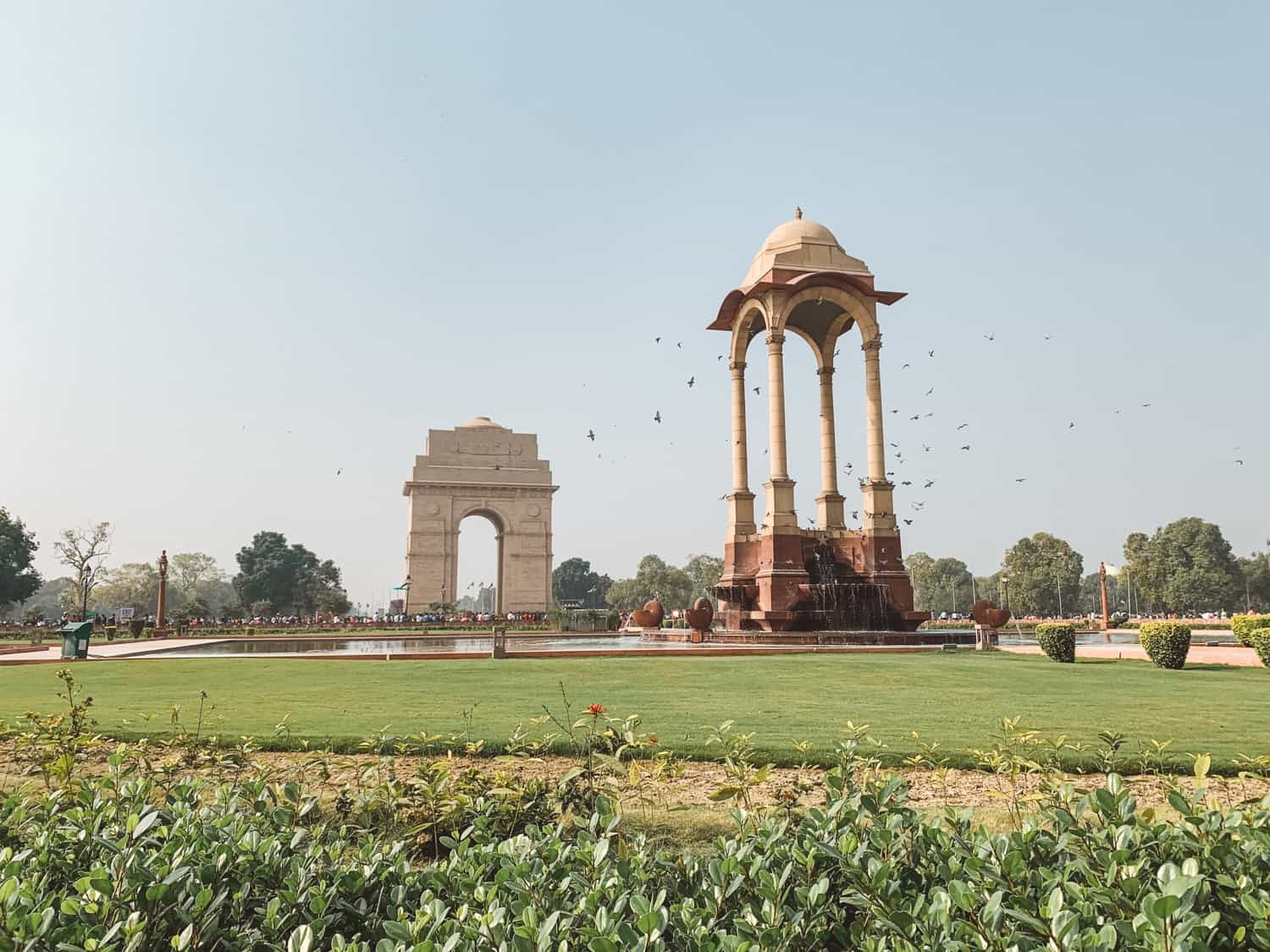
Why Should You Spend Time There?
Most people opt to visit the Golden Triangle because they see it as a way to ease into India travel. Visiting this part of the country showers you with incredible sites and it’s relatively easy to get around them all. There’s a well-worn tourist trail, excellent accommodation, plenty of transportation, lots of English spoken, and many attractions that are worth seeing. Here’s what I loved about it:
There are the most incredible monuments: The Taj Mahal receives all the glory and attention — and rightly so — but there’s so much more to see; structures that are almost as mind-blowing. I was particularly impressed by Jama Masjid, Humayun’s Tomb, Lodhi Garden, and Qutub Minar in Delhi. In Agra, Agra Fort and Itimad Ud Daulah Tomb were magnificent. And in Jaipur , I was blown away by Hawa Mahal, Amber Fort, and Jantar Mantar. Between Agra and Jaipur, I was spellbound by Fatehpur Sikri and Chand Baori. It felt like every few hours in the Golden Triangle I was witnessing one of the most spectacular sights of my life.
You can see three distinct parts of the country: Sure, you’re only seeing three cities, but doing so will give you a taste for three different regions. Jaipur will introduce you to the desert state of Rajasthan, Agra is in Uttar Pradesh, the state that’s known for its religious landmarks and pilgrimages, and Delhi is Delhi: there’s nowhere else in the world quite like it.
You’ll be exposed to plenty of confusion: Arriving in Delhi for the first time is an experience in itself. The smells that hit you as you step off the plane, the chaos of wandering the streets of Old Delhi, the crumbling buildings, the relentless sound of horns, the breathtaking temples and monuments, the incredible smells of dishes you’ve never heard of before, the colours, the crowds, the cultural immersion. It’s one of my favourite cities in the world because I can’t get enough of its chaos.
It’s an experience that every visitor of India ends up powering through, and you can get all of that iconic culture shock while exploring the Golden Triangle.
But it’s also pretty easy: It’s easy to get around by taking Ubers, it’s easy to book train tickets online and in advance, it’s easy to get around with Google Maps, everyone speaks English… Sure, you’ll be tending to the assault on your senses, but you’ll also feel safe as you do so. So many tourists visit the Golden Triangle, which makes it set up for visitors and easy to travel around.
There are options for all budgets: Want to get by on less than $10 a day? You can do that if you want to also skip out on all of the tourist attractions! I don’t recommend doing it, though. Want one of your most luxurious vacations at some of the best value prices? You can definitely do that, too! I travelled on a mid-range budget of around $30 a day and was astonished by how inexpensive everything was, from accommodation to transportation to food.
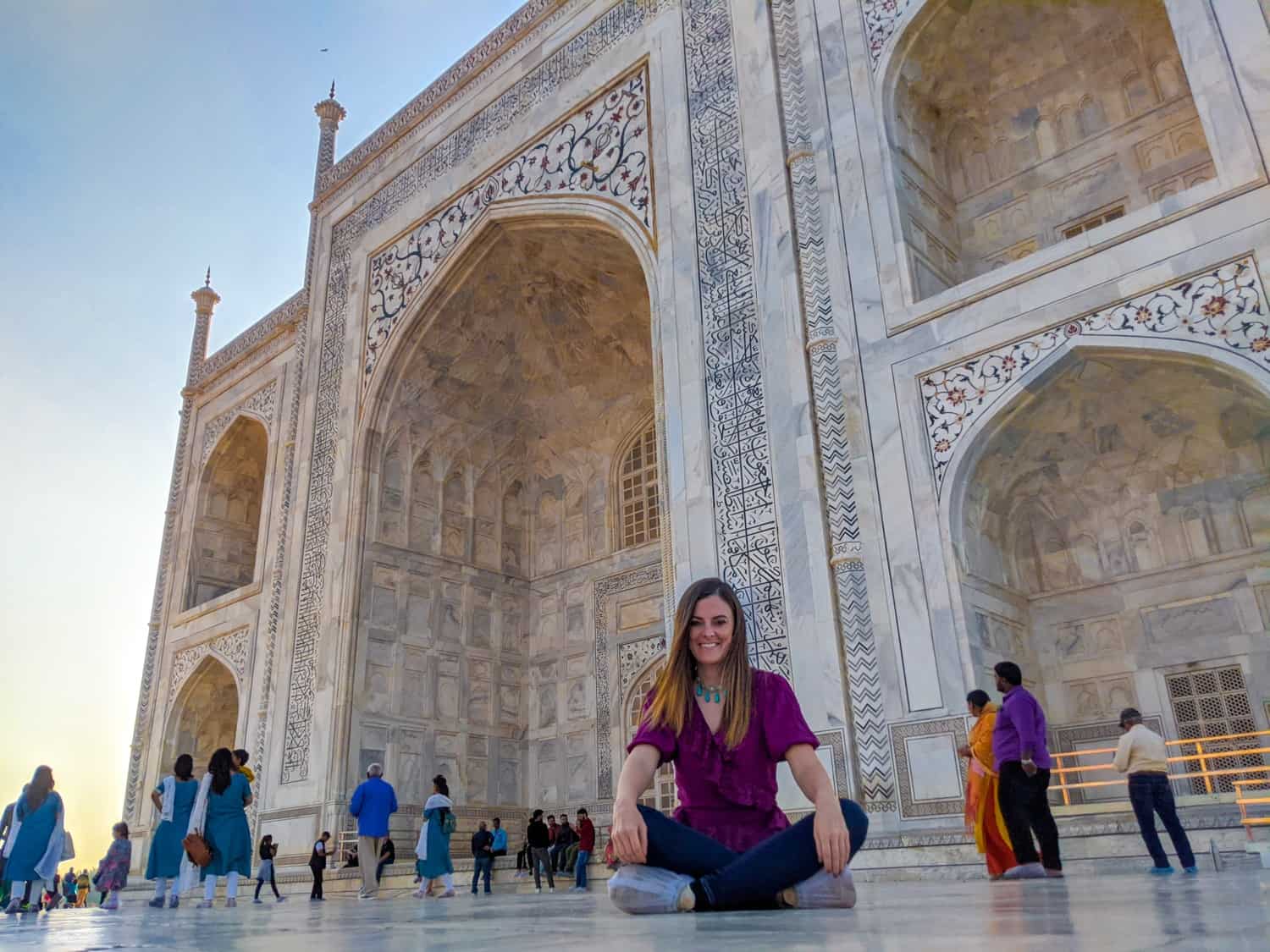
How Long Does it Take to See the Golden Triangle?
Most people choose to spend between three and seven days to cover the entire Golden Triangle, but I recommend a week as an absolute minimum. I opted for seven nights and eight days there and it felt like the perfect amount of time.
I spent four nights in New Delhi , one night in Agra, and two nights in Jaipur. If I’d had any extra days, I’d have likely added one to Agra to slow down the travel a little, but I didn’t really feel like it was needed.
Seven days, to me, is the perfect length of time to spend here.

How Do You Get Around?
I recommend taking the train from New Delhi to Agra, then hiring a driver to take you from Agra to Jaipur.
Taking the train from New Delhi to Agra is incredibly easy if you book in advance with 12Go Asia . Tickets for trains are released four months in advance, and it’s a simple process to buy them online. I took the Gatimaan Express — the fastest train in India — that left from Hazrat Nizamuddin station in New Delhi at 8:10 a.m. and arrived at Agra Cantt by 09:55 a.m. Tickets for A/C chair car carriages were just under $16 each and included a breakfast and bottle of water.
I recommend hiring a driver over taking a train between Agra and Jaipur, because there are so many interesting sites to see between the two cities. There’s no need to worry about booking a driver in advance, either — we asked at reception at our homestay in Agra the day before we wanted to leave and they arranged a driver for us for a reasonable price: 5000₹/$70 for around eight hours in the car, stopping at both Fatehpur Sikri and Abhaneri.
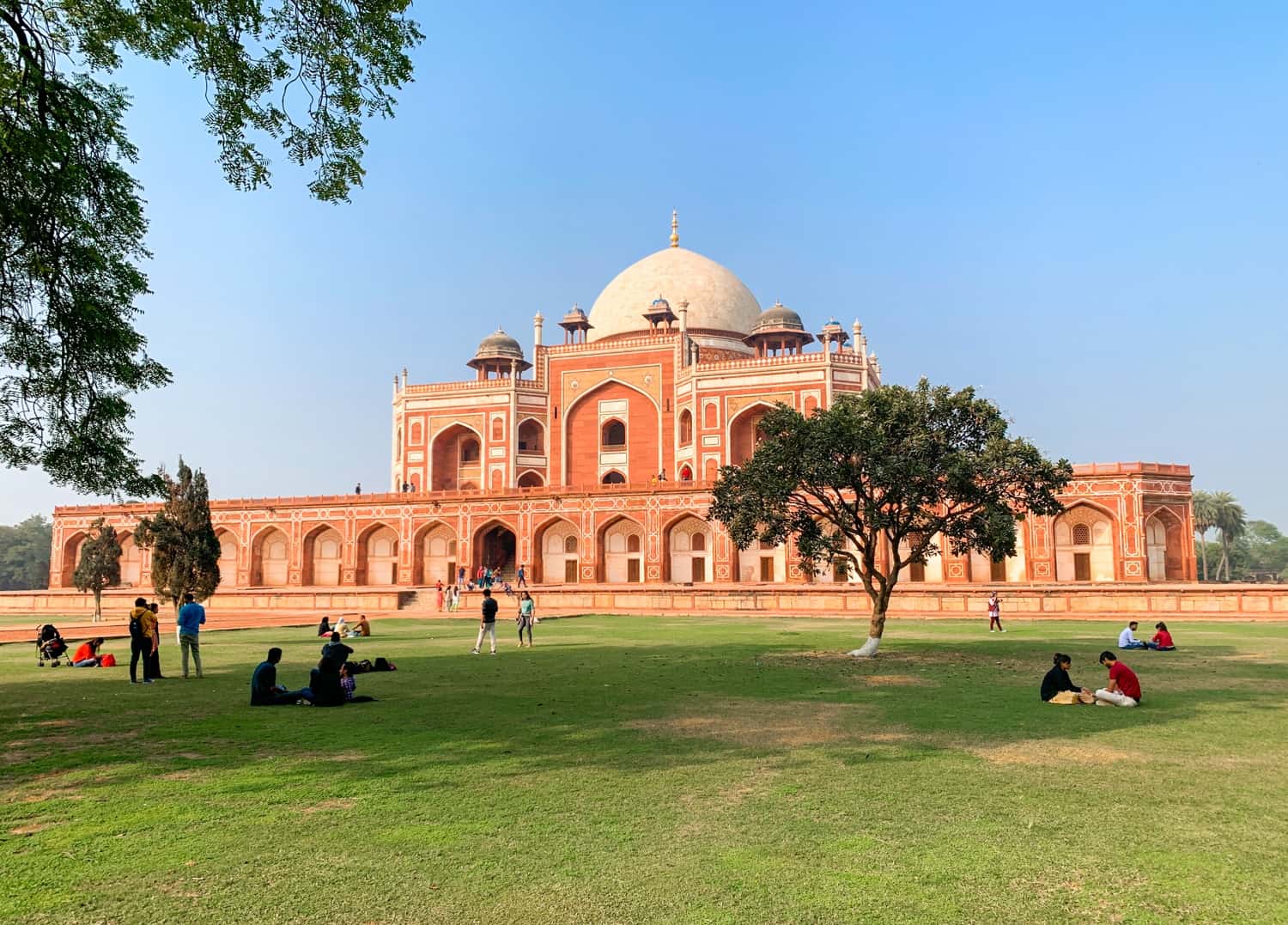
When’s the Best Time to Visit?
There isn’t a truly terrible time to visit this part of the world. All four seasons come with their own advantages and disadvantages.
I decided to touch down in Delhi at the start of December, as I wanted to travel in this part of the world during winter. The temperatures are perfect at this time of year. I encountered no rain and plenty of blue skies, with the middle of day reaching around 23°C/73°F and temperatures at night dropping to around 15°C/60°F. That’s the main advantage to visiting at this time — the manageable temperatures make dealing with the noise and chaos easier, and you’ll rarely feel hot and sweaty as you make your way around attractions.
There is one main disadvantage to travelling at this time of year, though: the smog. India is home to some of the world’s most polluted cities, and it was a struggle to deal with at times. My snot was jet-black for the entire time I was in Northern India. The smog stems from several sources: nearby farmers burning off their crops, the huge number of vehicles in cities, the dust emanating from construction sites, locals building fires to keep warm, and, depending on the time of year, firecrackers being set off to celebrate Diwali. Because the Golden Triangle resides in a land-locked valley, the smog tends to settle over the cities during cooler months and can result in a dense, dangerous haze.
The smog obviously affects your health, but it can also affect your sightseeing by washing out the sky in all of your photos. There’s fog to contend with, too. The Taj Mahal is notorious for being shrouded in fog in the early mornings in winter, barely visible as the sun begins to rise. In fact, we chose to visit the Taj at sunset rather than sunrise to avoid precisely that.
So what about other times of year?
April, May, and June are the hottest months of the year and I’d avoid visiting then — temperatures can get as high as 45°C during the day, which sounds like the worst possible way to see this part of the world. On the other hand, you’ll encounter the fewest number of tourists, which is always going to be a bonus in this often overcrowded region.
July to September are the monsoon months and come with a risk of flooding, as well as a high chance of rain hitting the pause button on your explorations. Alternatively, there’s little smog to contend with and the rain can clear up the skies to have your photos looking fantastic. Again, there are fewer tourists.
Overall, though, October to March has some of the best temperatures and the best weather. As long as you don’t mind having to deal with the smog, I’d recommend visiting then.
If I had to pick the perfect month to visit, I’d go with February. The temperatures will be lovely and warm, but there won’t be as much pollution and there’ll be slightly fewer tourists than in January and December.
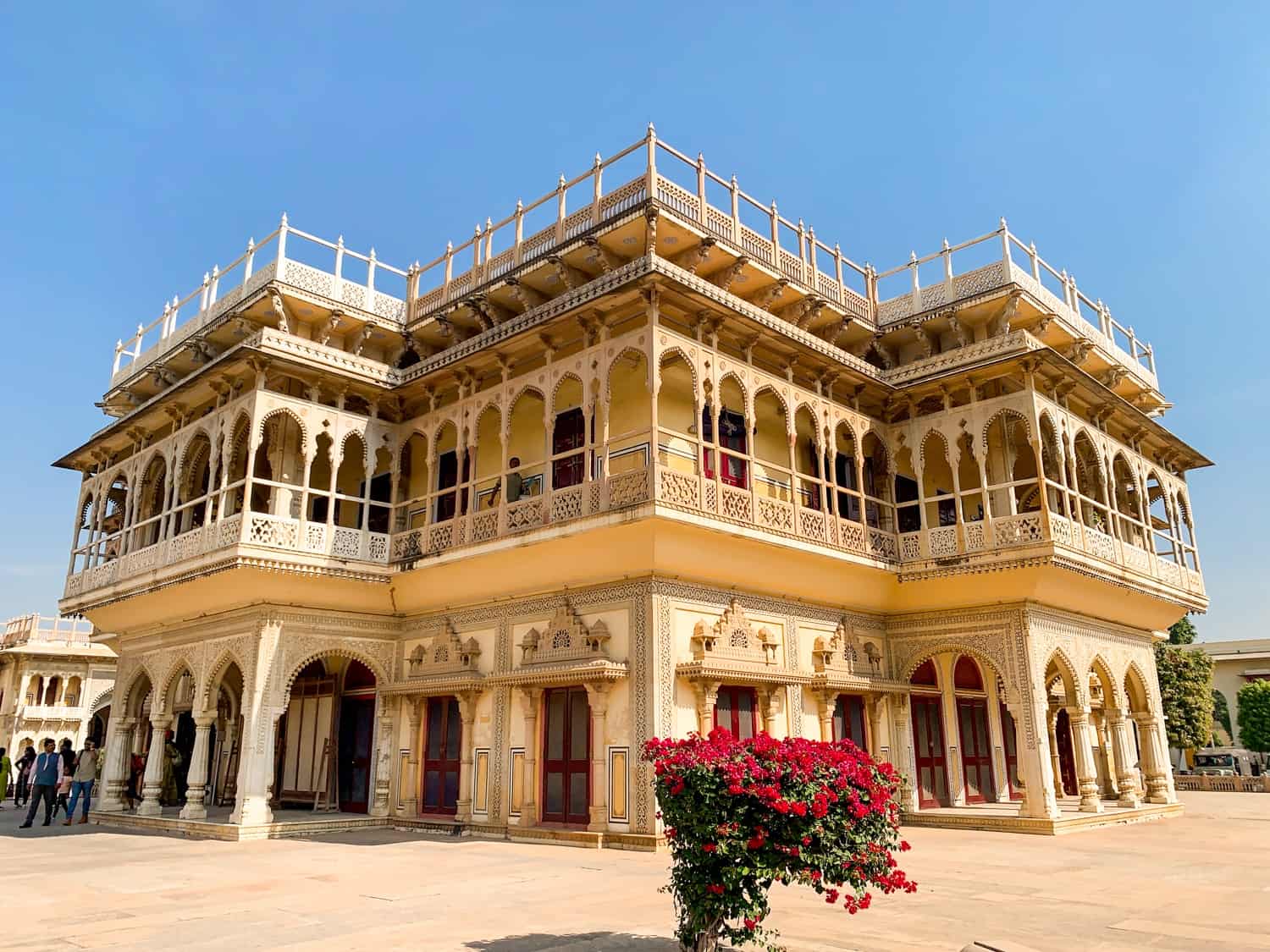
Should You Take a Tour?
Nah, there’s no real need to.
There are so many companies out there running tours to the Golden Triangle — many of whom are going to spam the comments of this post — but I really don’t think it’s necessary to take one. I found travel in the Golden Triangle to be straightforward and safe, and a hell of a lot of fun. There are so many tourists of all ages doing the exact same thing that it’s nowhere near as intimidating as you’re probably expecting.
Instead of taking a multi-day tour, I recommend opting for day tours while you’re on the ground — like the street food tour I did with UrbanAdventures in New Delhi. It was the perfect tour to take on my first day in the country as it introduced me to the country’s street food, and gave me the confidence to start ordering random snacks from vendors as I continued moving through India.
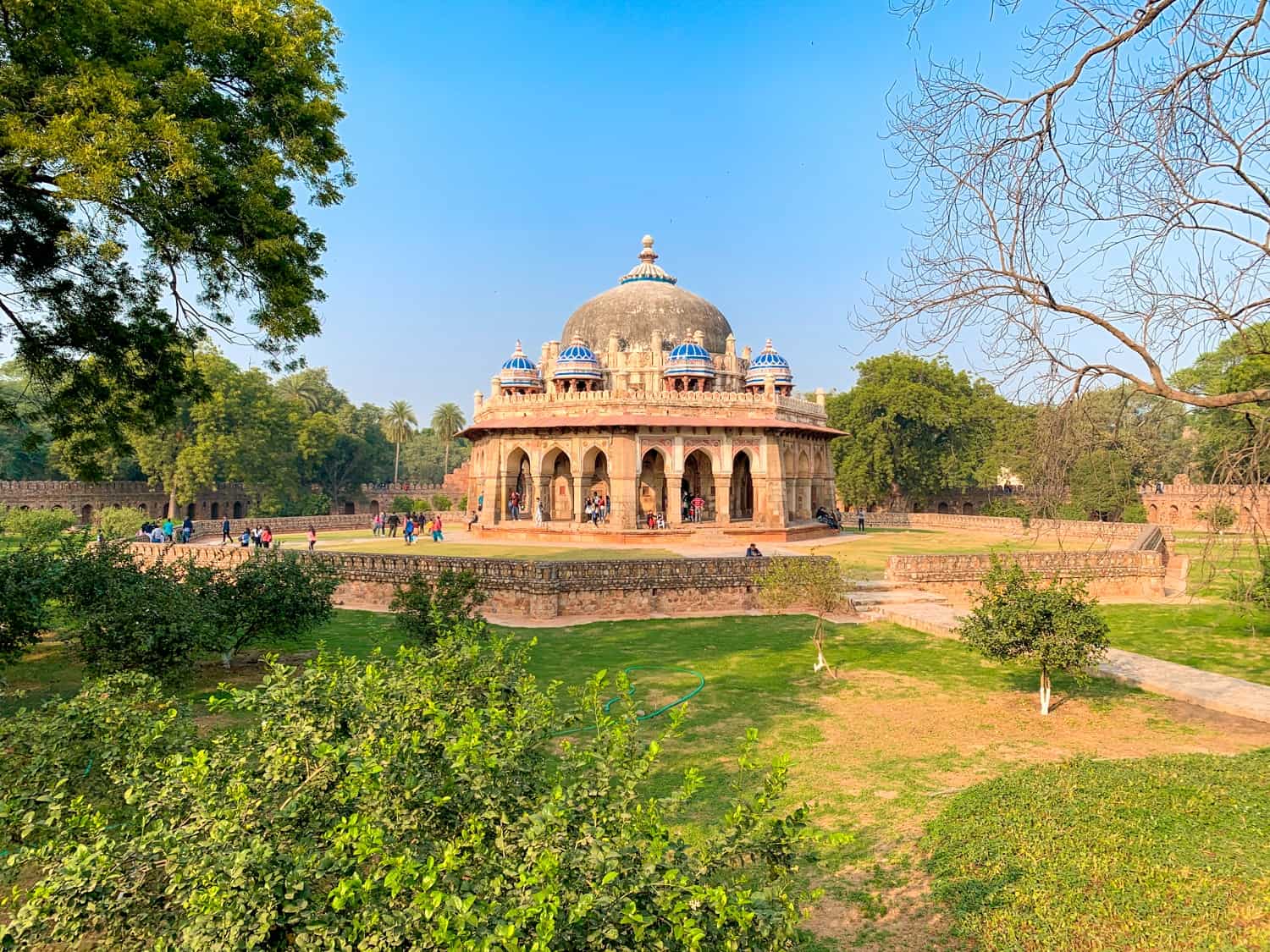
How to Spend Your Time in the Golden Triangle
This is my itinerary for my seven days in the Golden Triangle:
Day One: Arrive in New Delhi
Day Two: Explore Old Delhi
Day Three: Explore New Delhi
Day Four: Explore South Delhi
- Day Five: Train to Agra; Rickshaw tour of Agra
- Day Six: Drive to Jaipur, stopping at Fatehpur Sikri and Abhaneri
- Day Seven: Full day in Jaipur
I spent a lot of time in New Delhi, and that was for several reasons. I flew in from the U.K. and knew I was likely to be jet lagged during my first few days in the country — I always recommend giving yourself a few lowkey rest days at the start of your trip to get adjusted. I also knew that there was so much to see in Delhi and when I made a list of everything I wanted to do, I realised it was going to take several days to check all of it out.
In contrast, you can see all of Agra in a day and all of Jaipur in a day, so you don’t need to dedicate as much time to those places.
If you have less time, you can visit Agra and the Taj Mahal as a day trip, or even visit Jaipur as a day trip. It’d be a hardcore way of seeing the region and you’ll be weary afterwards, but it can definitely be done. You could spend one day in Delhi, take a day trip to Agra, take a day trip to Jaipur, and be done. Bam! Seen it in three days. It seems to me like a guaranteed way to not have a great time, though.
Here’s how I split up my time in more detail:
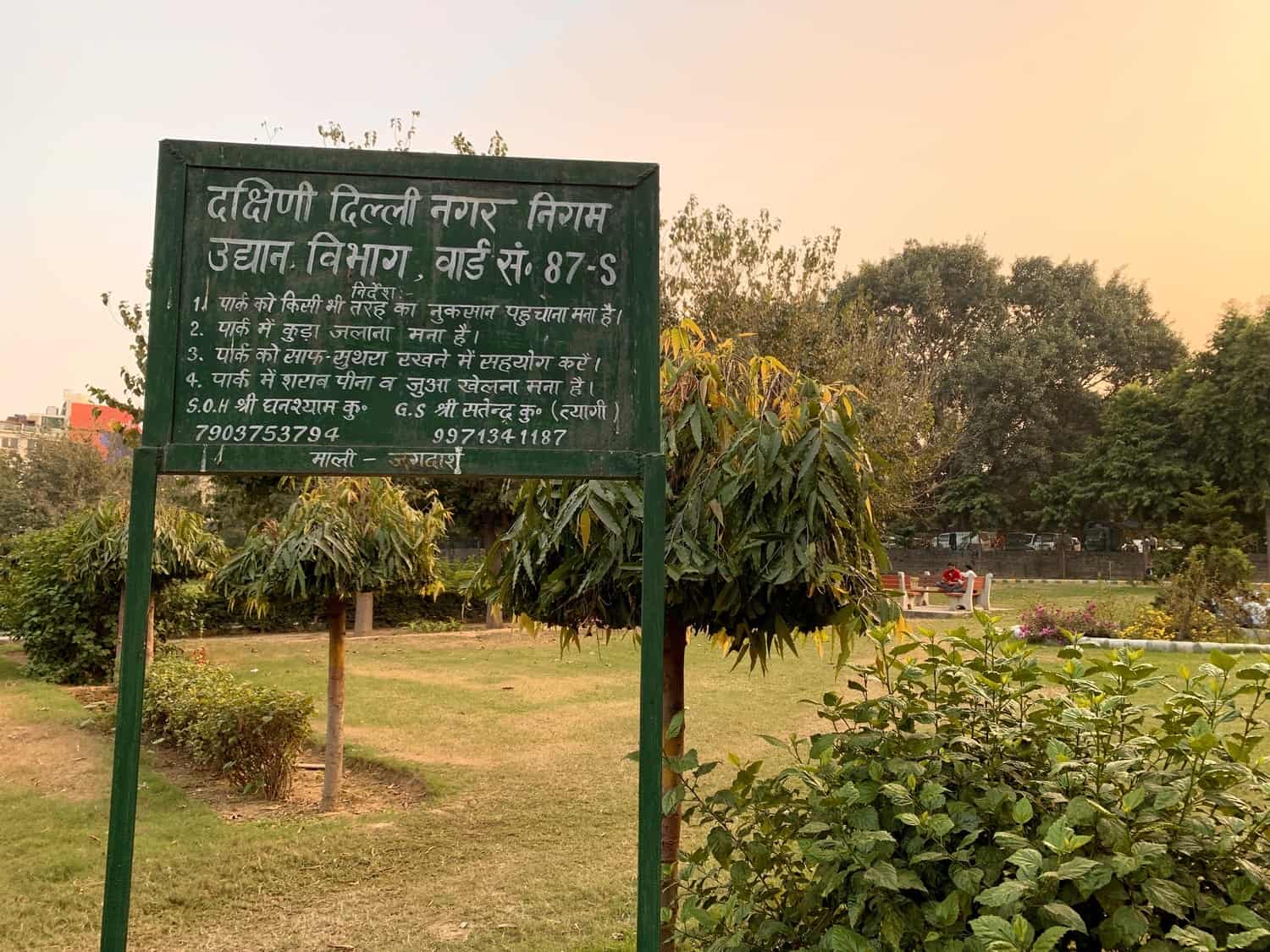
It’s a rule of mine to spend my first day in a new place relaxing. I highly recommend opting for accommodation in South Delhi for your first visit to the city. I stayed in Tatvamasi Guesthouse , which absolutely made our stay in Delhi so much better. The owner did so much for us, from showing us around the local night market to driving us to tourist attractions, introducing us to his favourite breakfast spot, and helping us get set up with SIM cards.
South Delhi is a chilled-out, middle-class neighbourhood, and depending on what time you arrive in Delhi, it’s a good place to kick off your explorations. Head out for a walk, wander around one of the parks, people-watch on the streets, and check out one of the local cafes.
Spend your evening on a street food tour to introduce you to Delhi and the Indian food scene, and build up your confidence to go it alone in the future. Our guide offered so many valuable tips on this tour and I learned so much about Delhi from her.
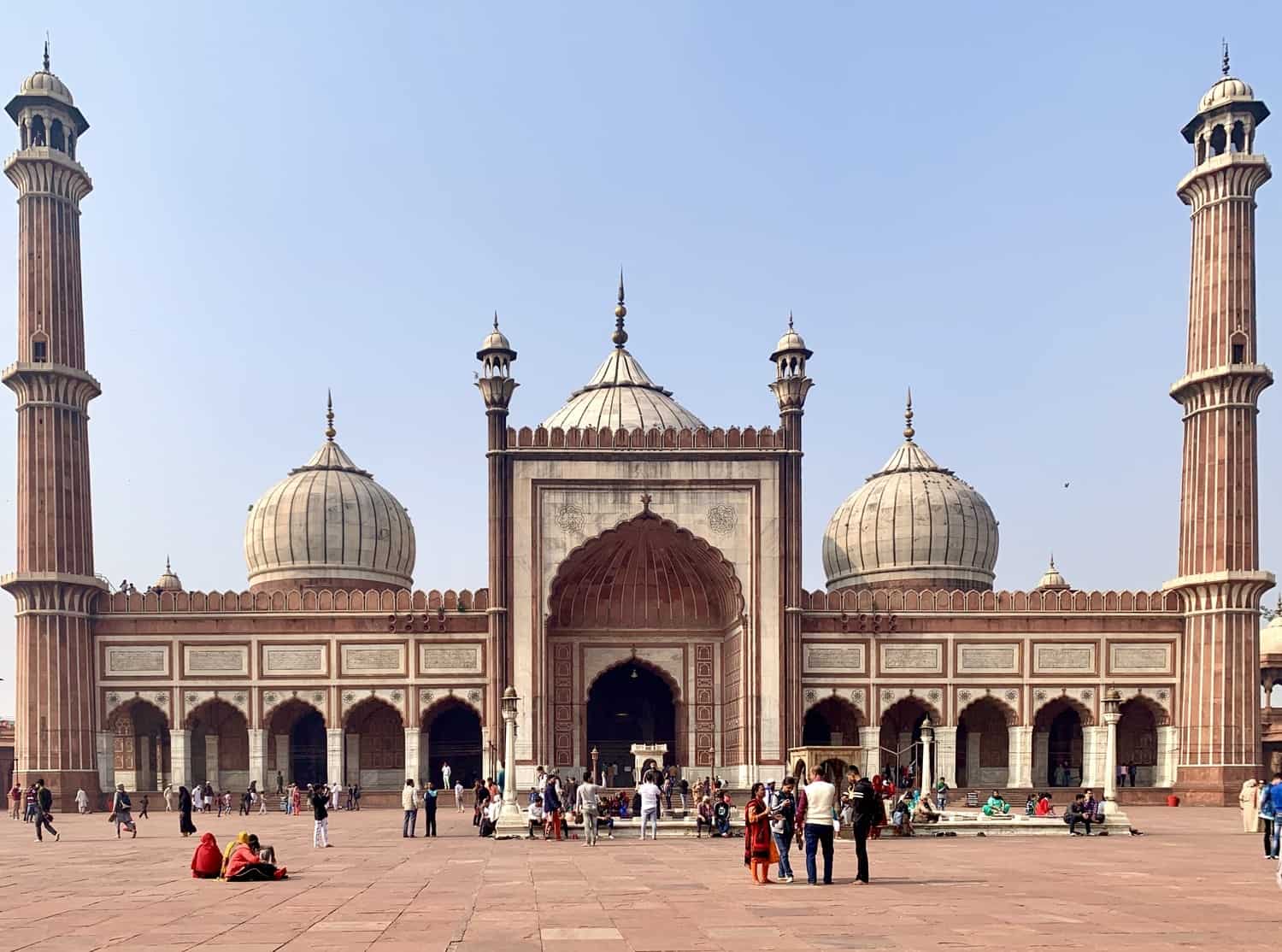
Old Delhi is likely what you’re picturing in your mind when you imagine the chaos of India. The streets are crammed with rickshaws and motorbikes and cows and goats and street food and so many people and so much noise.
Start your day, though, by heading to the Red Fort when it opens. Without the crowds of tourists, it’ll bring about a peaceful start to a day that’s likely to be anything but.
Make Jama Masjid your next stop: one of the largest mosques in Delhi and one of my favourite spots in the city. Excitingly, you can pay to climb to the top of one of the minarets for a fantastic view over Old Delhi.
Gandhi’s memorial should be your next port of call for some reflection and serenity, before you take a deep breath and head into the Old Delhi neighbourhood. This is where you’ll want to have your camera at the ready, knowing that there’ll be so much going on that it’s impossible to capture it all in one still frame. It’s fun trying to, though.
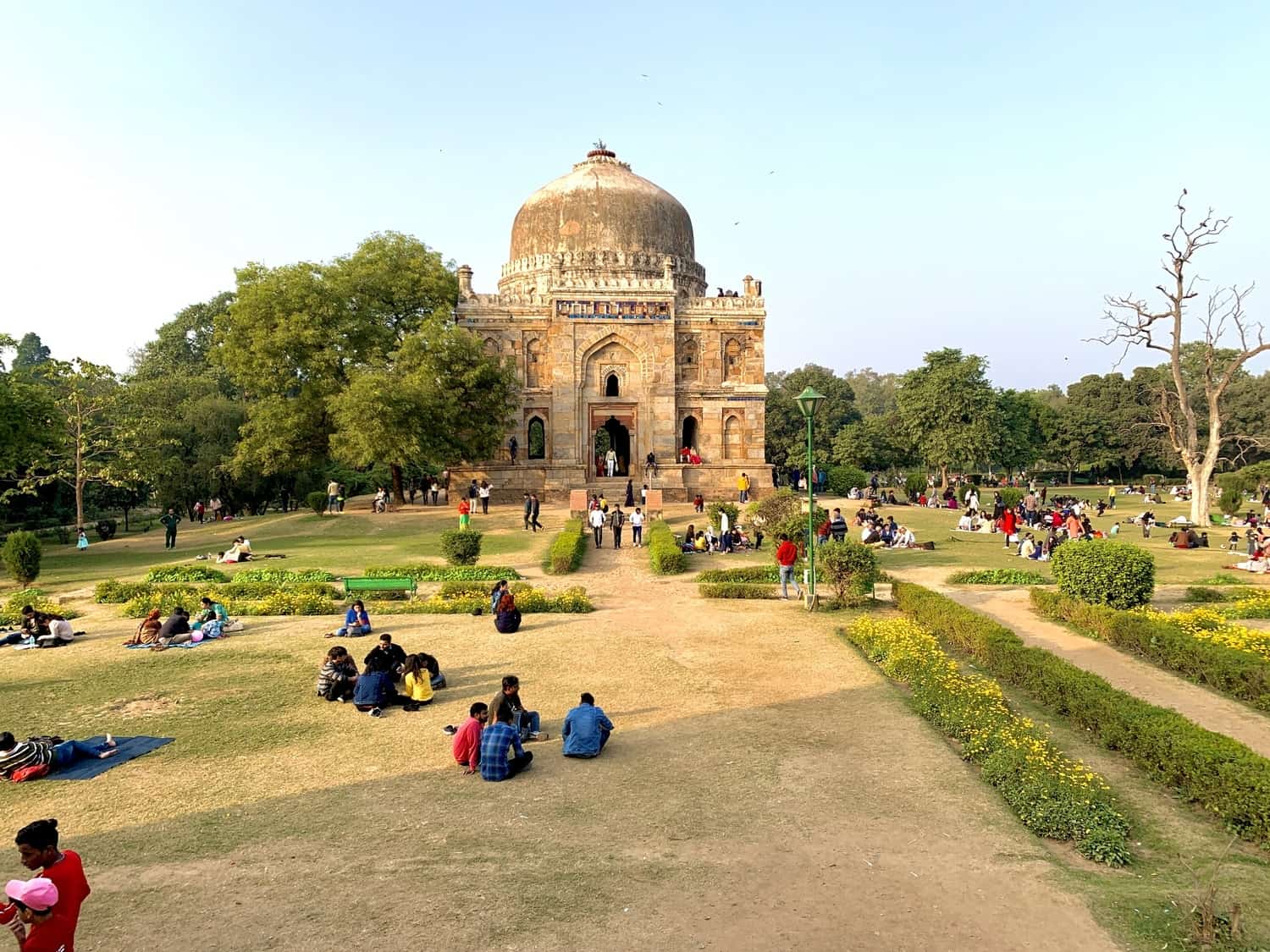
Today is all about exploring New Delhi. Start by heading to your first stepwell in India! I love stepwells — they’re so cool for taking photos — and Agrasen ki Baoli was a fascinating one. It’s supposedly one of the most haunted places in Delhi!
Next, head to India Gate. This war memorial is dedicated to the 70,000 soldiers in the British Indian Army who died fighting in the First World War. It’s full of tourists, local schoolkids, and families having picnics, as well as tons of street vendors, but it’s an impressive structure nonetheless.
Humayun’s Tomb will likely be one of your biggest highlights of New Delhi. The red sandstone tomb was built in 1570 and was the inspiration behind the Taj Mahal. It’s a large complex that you could see in an hour or three, depending on how keen you are to linger and take lots of breaks to soak up the atmosphere. I loved it here.
Head to Lodhi Gardens next, which is another one of my favourite places in the city. It’s such a cool park! You could easily spend a couple of hours walking around the old historic monuments and watching families play cricket and picnic on the grass.
Finish off your long day of sightseeing with a stroll through nearby Lodhi Colony, an area of the city that’s been turned into a neighbourhood of street art. There are dozens of enormous colourful murals blanketing the buildings around here, and they’re so much fun to hunt down.

Finish off your time in Delhi with a relaxed stroll around South Delhi. Get started with an amble around the Lotus Temple, a Sydney Opera House-esque house of worship that’s open to everyone, regardless of their religion.
Next, head to Qutub Minar. A UNESCO World Heritage site, this towering minaret reaches a height of 73 metres and is surrounded by so many cool ruins and monuments. It was one of my favourite spots in Delhi — I know I’ve said this a lot — and I spent over an hour taking photos in the grounds.
In the afternoon, head to the PVR Directors Cut cinema to watch a Bollywood movie. This is a luxury cinema in South Delhi, with comfortable chairs that recline, blankets, pillows, air purifiers, and waiters to bring meals to your seat.
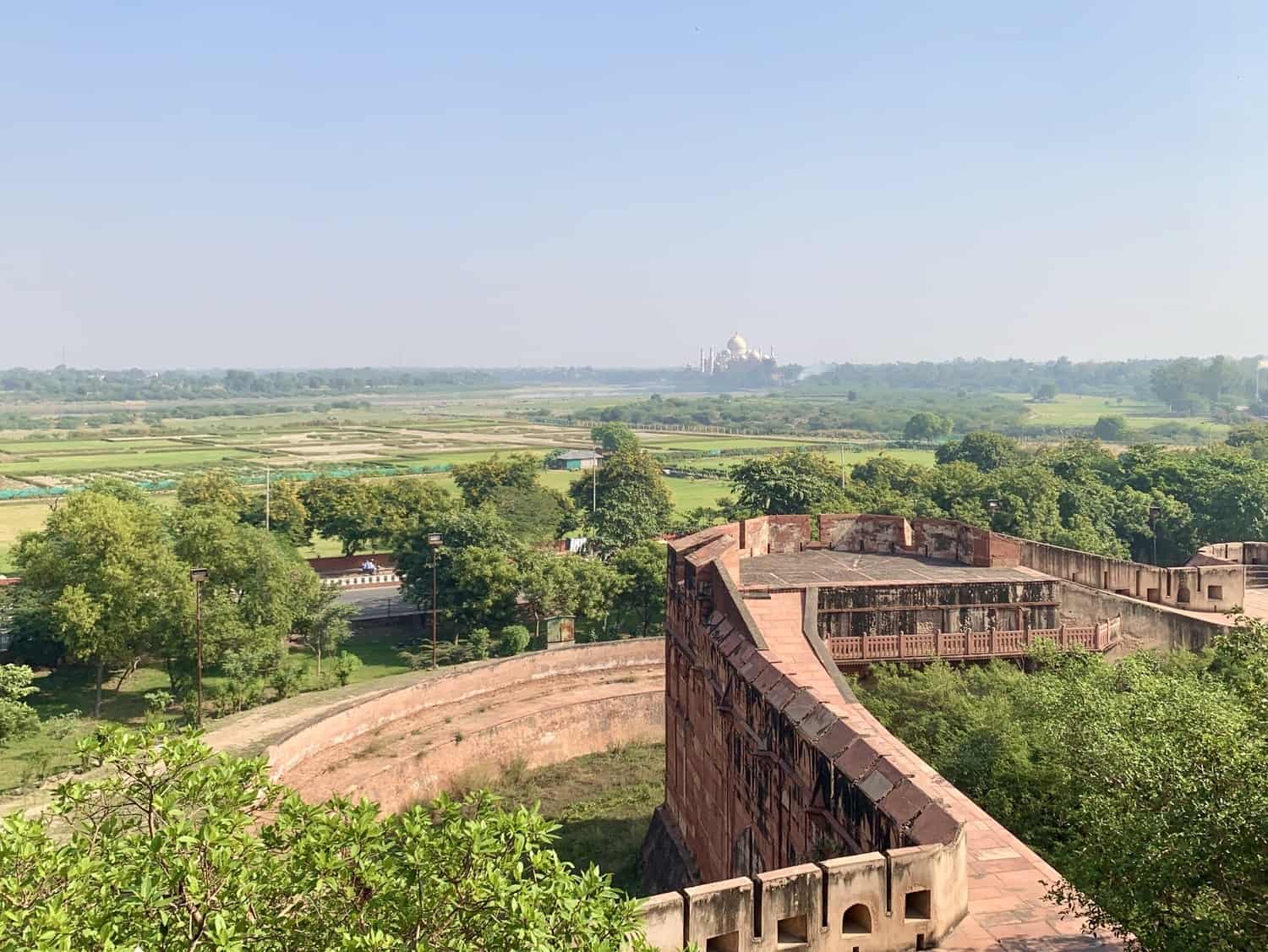
Day Five: Agra
Take the Gatimaan Express train from Delhi and you’ll arrive in Agra just before midday. After checking in to your homestay — I stayed in this lovely one — and arranging a driver for the following day, it’s time to head out and find yourself a rickshaw driver to take you around for the day.
Make Agra Fort your first stop and prepare to be impressed by the sprawling complex. I was surprised I managed to spend well over an hour roaming around, and I found it far more impressive than Delhi’s Red Fort. There are tons of views of the Taj Mahal from the fort, so make sure you’re looking out for it as you walk through the grounds.
The Baby Taj, or Itimad Ud Daulah Tomb, will be next on your agenda, and it’s usually not too crowded. This is a time to chill out and enjoy taking photos from all different angles of the tiles and structures in the gardens.
Ask to be taken to the Taj Mahal viewpoint next, on the other side of the river and looking out towards the mausoleum. This is a great spot for taking photos in front of the Taj without anybody else in the shot.
And then it’s time for the main event. If you’re visiting Agra in winter, as I was, I recommend a sunset visit to the Taj Mahal to avoid the fog that rolls in every morning at sunrise at this time of year. You’ll likely spend hours here and if you expect it to be overrated, you’ll only be impressed.
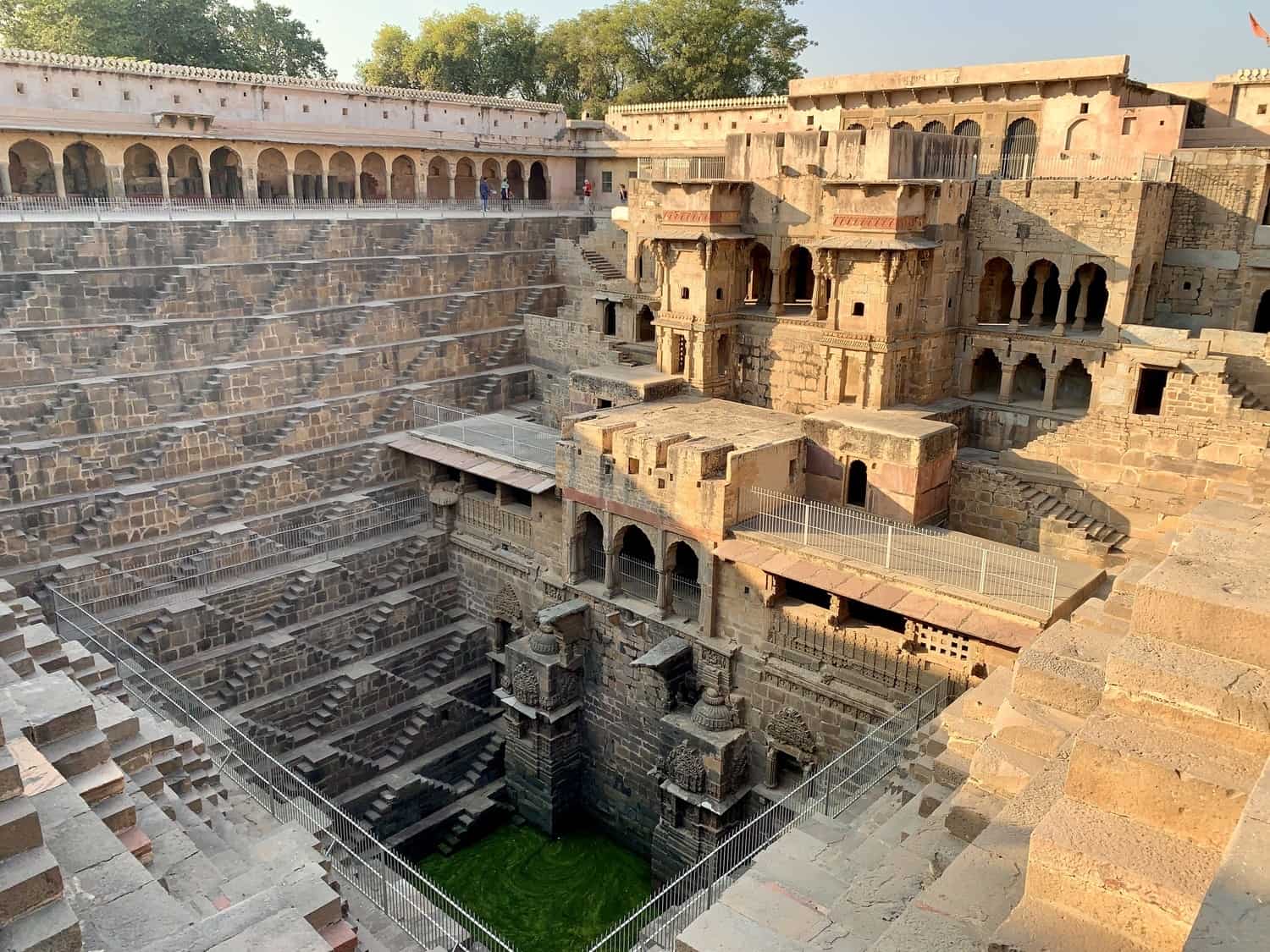
Day Six: Travel Day from Agra to Jaipur, via Fatehpur Sikri and Abhaneri
If you opted to skip the Taj Mahal at sunset the previous day, you’ll be heading out at sunrise this morning instead. Or why not both? I was tempted to return at sunrise just to see it again, but in the end, my desire to sleep won out.
After a quick breakfast, it’ll be time to jump in the car with your driver and make your way to Jaipur.
Your first stop along the way will be Fatehpur Sikri, about an hour away from Agra. You’ll likely spend two or three hours here, as there’s so much to see. The fortified city dates back to the 16th century and was the capital of the Mughal Empire for just over 10 years. After that time, it was swiftly abandoned due to a lack of fresh water, yet the red sandstone buildin gs are still perfectly preserved today.
After two hours on the road, you’ll be arriving in Abhaneri to have a look around India’s largest stepwell. It’s known as Chand Baori and is one of the most impressive in the country. Built in 800 AD, it has 3500 steps and drops 100 feet down, making it one of the deepest in the world.
That night, stay in Le Fort Homestay . There are fantastic breakfasts up for grabs, the hotel is next to some great restaurants, and the owner is so helpful. The guesthouse is built right up against a fort, which makes for a particularly cool location. I loved it here.
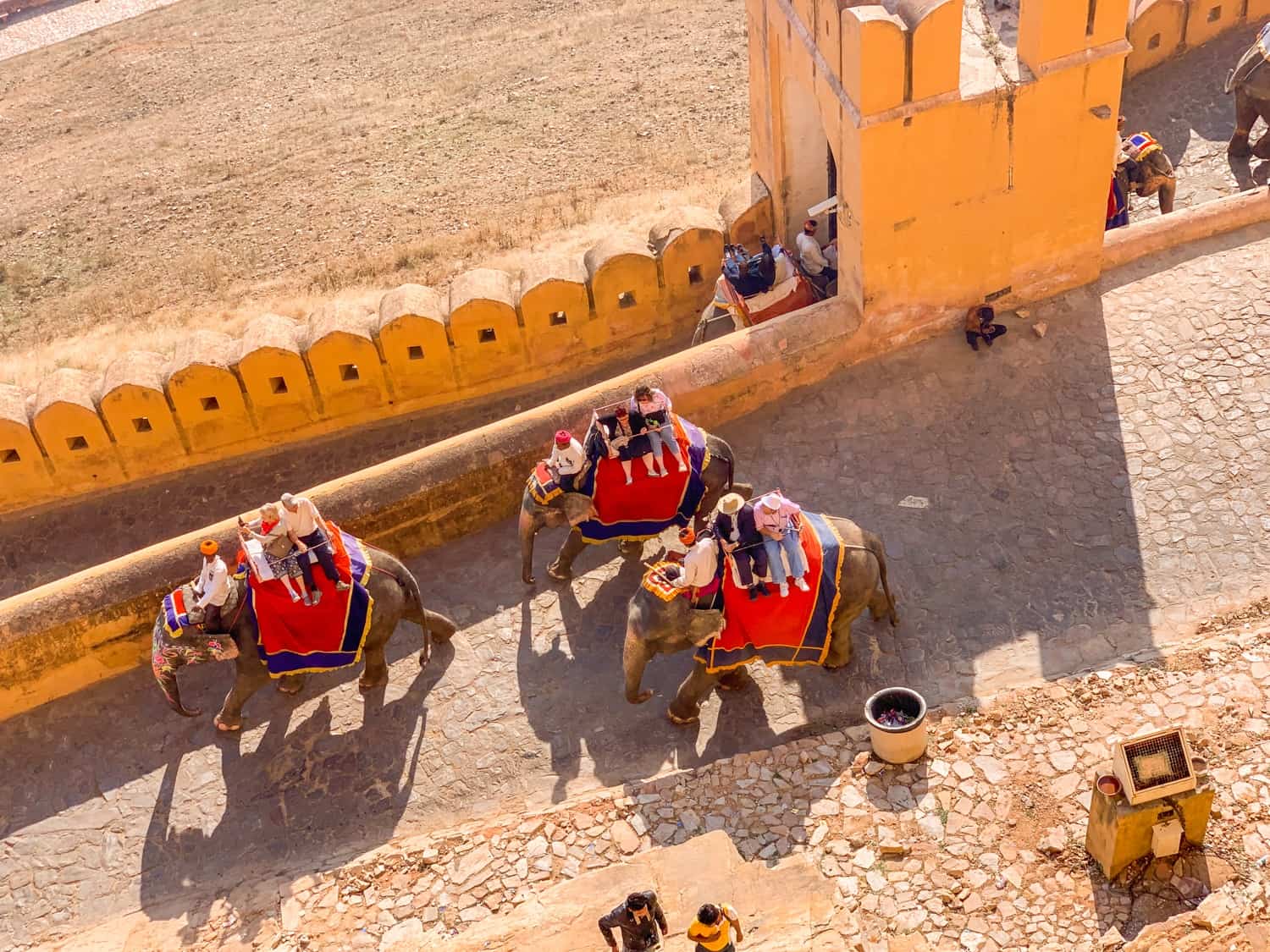
Day Seven: Exploring Jaipur
There’s so much to see in this beautiful pink-coloured city but fortunately, you can visit all of the tourist attractions in a single day.
Amber Fort should be the first stop on your agenda, as you’ll want to get there as soon as it opens in order to avoid the crowds. I’d be aiming to leave Jaipur at 7:30 in the morning and then jumping in an Uber to get there for opening time.
Once the fort opens, you’ll want to make the most of having it all to yourself, so prioritise seeing the most popular parts of the complex: the Hall of Mirrors is usually packed, so head straight there. Once you’ve walked through the four areas of Amber Fort, make the trek over to Jaigarh Fort and spent an hour taking photos from its walls.
With the main attraction out of the way, jump in an Uber back towards Jaipur and stop off at the lake palace.
With that, it’ll be back to Jaipur, so grab a rickshaw and ask the driver to take you to Hawa Mahal. Rather than rushing, take photos from both sides of the street, and head inside to have a look around. Make sure to grab a chai from the Wind View Cafe opposite to get one of the best views of the Hawa Mahal without traffic getting in the way.
While you’re in the old city, head next to the City Palace and Jantar Mantar, and enjoy snapping photos of the pink buildings on the way. I’d suggest potentially skipping the city palace if you’re running short on time, as it was the least impressive part of Jaipur for me.
If you’re still feeling energised, you should head next to Nahargarh Fort, for an incredible view of the city. Visiting for sunset would be a great way to watch darkness fall over Jaipur.
Alternative Destinations in the Golden Triangle
If you have more time or don’t want to dedicate as much of your itinerary to Delhi, there are plenty of alternative places to check out or tack on to your itinerary.
You could work in a stop at Ranthambore National Park in between visiting Agra and Jaipur. This wildlife reserve is a former royal hunting ground and is now one of the best places in the country to spot wild Indian tigers on safari. You aren’t guaranteed to see them, of course, but if you have an extra few days to spare, it’d definitely be worth taking that chance.
UNESCO World Heritage Site Keoladeo Ghana National Park is close to Agra and could be worked into your drive to Jaipur if you’re a keen birdwatcher. At Sariska National Park, near to Jaipur, growing numbers of leopards and tigers roam through the area.
If you wanted to hire a driver between Delhi and Agra, you could stop in Mathura, birthplace of Krishna, along the way, as well as Vrindavan, which is filled with beautiful temples.
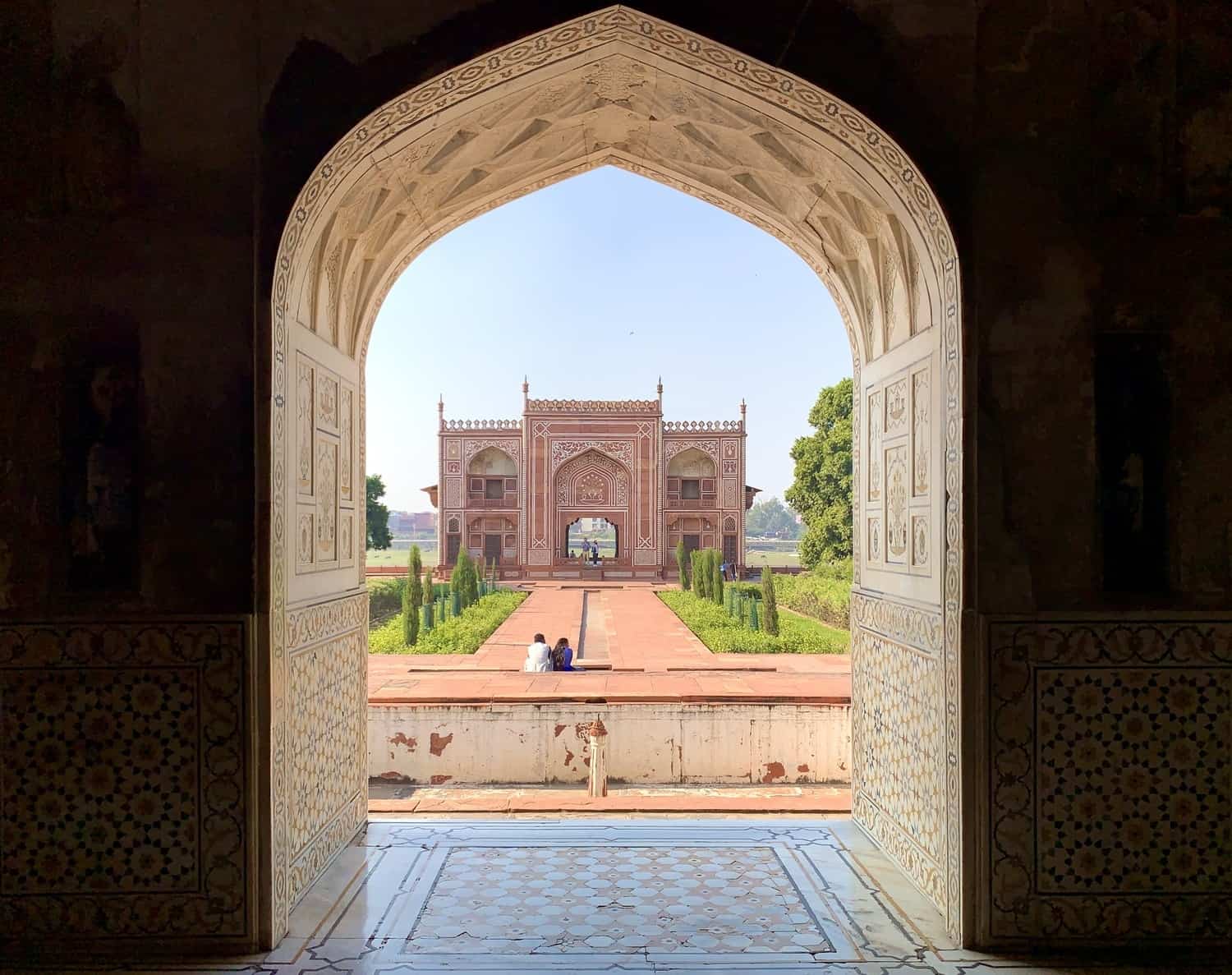
Travel Tips and Advice for the Golden Triangle
Use Uber or Ola to get around: Uber and Ola (the Indian version of Uber) have been game-changers for travel in India. We found ourselves using Uber more, as we could pay through the app. With Ola, you’ll need to pay in cash, as the app doesn’t accept foreign cards, but prices will be slightly cheaper.
As much as I enjoy the rickshaw life, having to haggle with drivers is annoying, and so is running the risk of them taking us to the wrong place because they misunderstood our directions. And plus, the pollution can get so bad that driving in an open-air vehicle isn’t going to be great for your lungs.
I found Uber to be great for giving me a maximum price for which to haggle rickshaw drivers down to. When you can show the drivers the rate for Uber on your phone, they’re usually happy to match it. And it’s cheap! I couldn’t believe it when a 90-minute drive across Delhi worked out at around $10.
And 12Go Asia for trains: In the past, there used to be so many horror stories around trying to take the trains in India — it wasn’t uncommon to have to spend all day queueing to buy tickets or ending up in the packed-to-the-brim general admission carriage or getting scammed when you tried to buy tickets from travel agents.
Just like Uber, 12Go Asia has vastly improved the train-booking situation in the country, because now you can book online, up to four months in advance and with your debit cards you use at home. 12Go takes a commission on sales, so keep that in mind — but it was so worth it for me to just have that peace of mind that everything was booked.
And Redbus for buses: I took three buses while I was in India and was impressed by the quality of all of them. The buses are cheaper than the trains, so are a great option if you’re travelling on a budget. Make sure you look at the seat map in advance — some of the buses are sleepers, arranged with a double bed on one side of the bus and a single bed on the other. For all my solo female travellers out there: you’ll want to make sure you book a single bed so you don’t end up sharing one with a random local dude. I booked the buses through Redbus .
English is spoken everywhere: No need to worry about language barriers here, as English is widely spoken throughout India, and especially in the Golden Triangle. If you’re doing anything even remotely touristy, you’ll be able to communicate with anyone you need to.
Some attractions close on Friday/Monday: Did you know that the Taj Mahal is closed on Fridays? I didn’t before I arrived in the country, but fortunately, I had planned to visit on a Tuesday.
What I did do, however, was to plan to visit the Lotus Temple on a Monday — my last day in New Delhi — and it was closed. If I’d researched in advance, I’d have known about this and been able to squeeze it in to one of my other sightseeing days.
When you’re planning out your itinerary for India, make sure you have a quick google of the opening times of anywhere you want to visit — Mondays are usually when museums and attractions are closed.
Get a SIM card: It’s so easy to get a local SIM card in India. There’s an Airtel stand in the arrivals area at New Delhi — they’ll take a scan of your passport, put the SIM card in for you, and activate it. The cost of data in India is low — 900 rupees ($13) for 1.5 GB of data and unlimited local calls if you buy it from the airport or 250 rupees for the same if you go into an Airtel store in Delhi. The latter will be a more complicated process.
Haggle, but also don’t care that much: You’re expected to haggle in India, but the prices are often so low that you should keep in mind what you’re arguing over. I spent a solid five minutes trying to get a rickshaw driver to lower his price by 50 Rupees, which is the USD equivalent of 70 cents. I was being ridiculous! And honestly? Who cares if you get ripped off by a dollar? The drivers need the money more than you do.
You can pay by card to get a discount: The vast majority of tourist attractions in India offer a discount if you pay by card instead of cash. It’s not much of a discount, I’ll admit, but it all adds up in the end. We didn’t have a problem using our British debit cards at the entrance to any attractions.
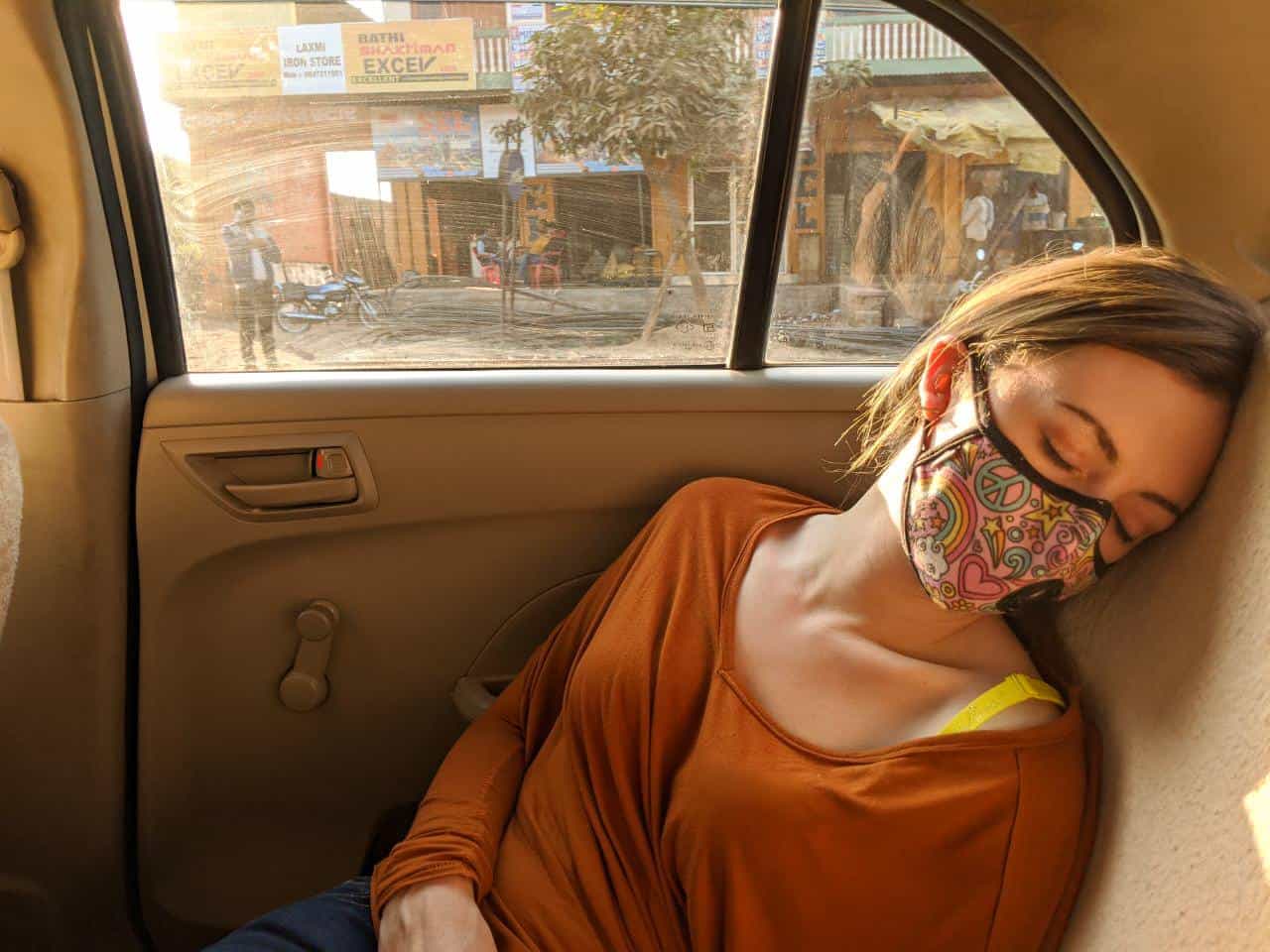
Buy a N95 mask in preparation for the pollution: The pollution is brutal in this part of India, so grab an N95 mask in advance.
N95 masks filter out 95% of fine particles that are less than 2.5 microns in size, which can be significantly harmful to your health. You’ll want to make sure you have a tight fit with your mask — if you can feel any air coming out the sides when you exhale, that means it’s not airtight and you’re still breathing in the toxic fumes around you. You’ll know it’s working because it’ll feel hard to breathe.
They’re not the most comfortable to wear and use, but I still used mine every day for at least a few hours in order to minimise my exposure.
Steer clear of the street dogs: I had a rabies scare while I was in India, and ever since, I’ve vowed to spread the word about how it can be contracted. I’ve learned a lot about it over the past month.
Rabies is spread through the saliva of an infected animal — and that doesn’t just mean being bitten by a dog that’s foaming at the mouth. It can be transmitted by an animal that isn’t showing symptoms, and it can spread through scratches and licks, as well as bites. If you get saliva on your hands, you can catch rabies through touching your eyes, nose, and mouth — even if it’s several hours later.
The street dogs in India are adorable, and I know I spent a lot of time playing with them, but I was being stupid and it’s just not worth the risk. India has the highest prevalence of rabies in the world, with an estimated 30,000 deaths each year. Once you contract rabies and start showing symptoms, there is no cure and you’ll die within a week. Avoid the dogs, no matter how cute they may be because it’s just not worth the risk.
And if you do come into contact with a dog and it licks a bite on your leg or whatever, see a doctor and get the post-exposure treatment as soon as possible. It’s a series of injections spread out over two weeks and it stops you from dying. When it comes to rabies, you don’t want to ever take the risk.
Watch out for the drains: Despite looking like they’re secure in the streets, the drain covers are sometimes loosely placed over the sewers and can flip over and send you flying down below if you step on them in the right place. Look at your feet while you’re walking to avoid this.
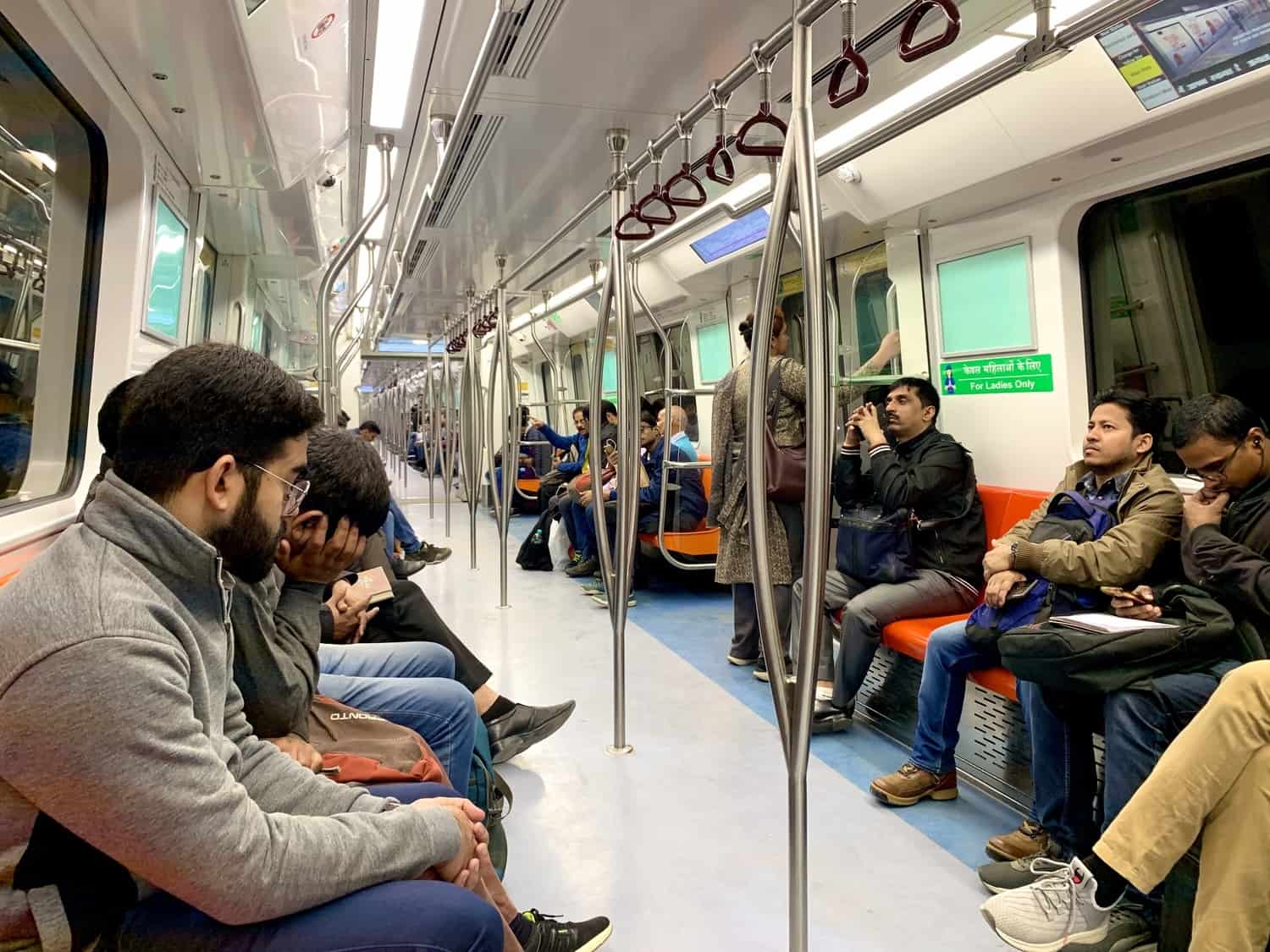
How to Stay Safe as a Woman in India
I received vastly less hassle in India than I was expecting. I encountered zero sexual harassment, no touching, and very little staring from the local men. Everyone treated me with respect and warmth, whether I was with my boyfriend or walking around on my own. This was very unexpected!
The worst you’ll likely encounter is incessant requests for photos from teenage boys. At first, I agreed to have my photo taken with everyone who asked, but eventually got fed up and started turning them down. After all, if they weren’t asking the local girls for photos, why were they asking me? They just want to pretend they have a Western girlfriend on social media.
My tour guide in Jaipur advised me to stop agreeing to take photos with local guys, and from that moment on, I only agreed to for families and teenage girls.
It might surprise you to learn that travelling as a woman in India can sometimes make for a more enjoyable experience. There are women-only carriages on the Delhi Metro that are far less crowded, I could skip the queue for many attractions by joining the smaller one for women, and was frequently welcomed with open arms by local women. Teenage girls, in particular, were always down to hang out and chat with me.
Over and over, like when I was travelling alone by train, locals would check with me to make sure I felt safe, and reassure me that if ever I felt uncomfortable or in danger, I could just let them know.
In the Golden Triangle, there are so many tourists that you’re not going to stand out in a crowd, but you should still follow basic safety practices.
You’ll want to make sure you dress conservatively to attract less attention, stick to well-lit areas when out at night, keep your belongings close to your body, and never compromise your safety in order to save money. If somebody tries to grope you, yell at them and dozens of nearby locals will come to your rescue. I also recommend staying in homestays that receive positive reviews from solo women, and to arrange a pick-up with them when you arrive in town, especially if you’ll be doing so at night.
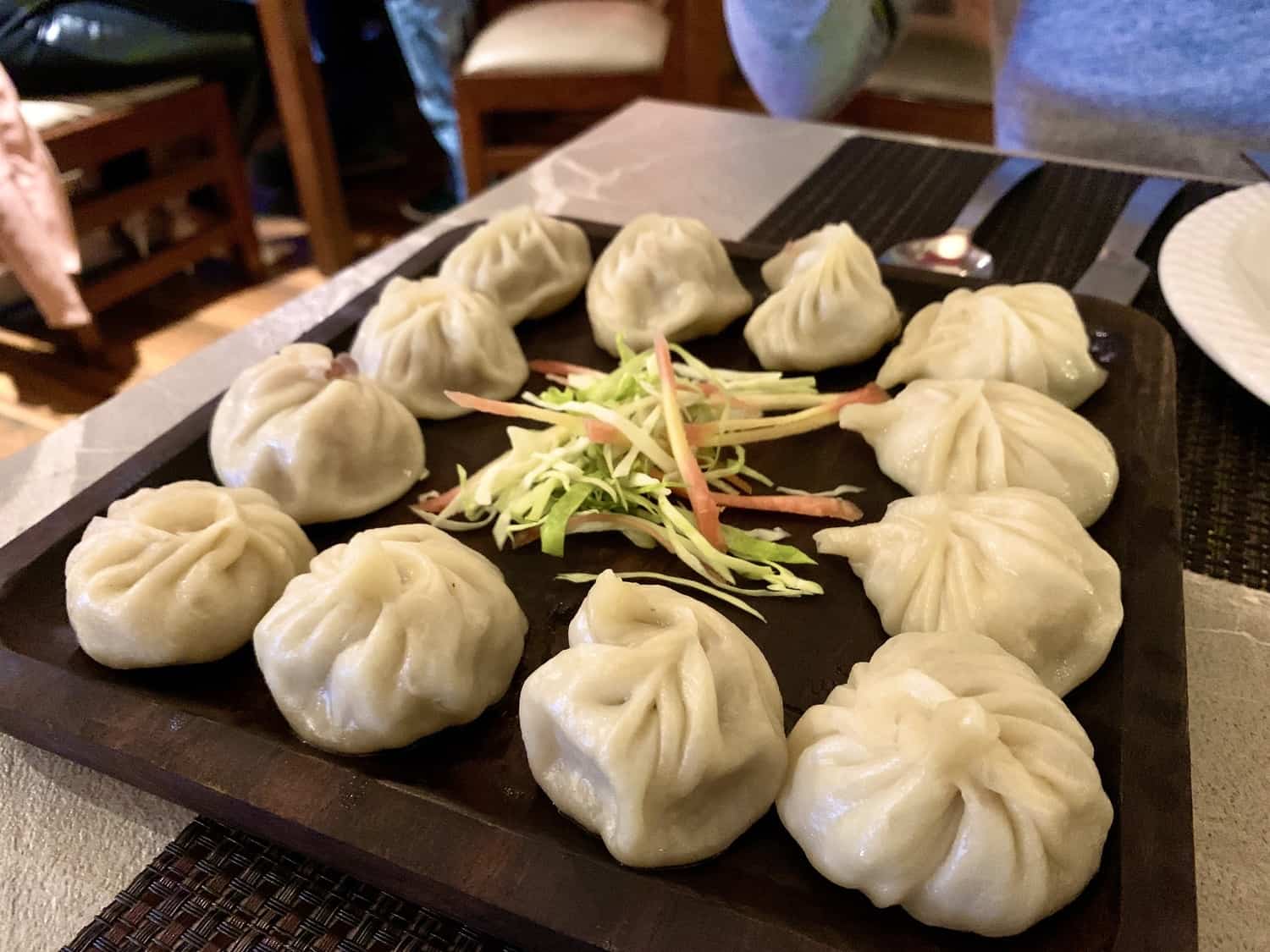
What About Delhi Belly, Tho?
Delhi Belly: my biggest fear. I was absolutely convinced I would get food poisoning in India, because doesn’t it happen to everyone?
And yet, it didn’t. Despite eating pretty much anywhere that was serving up delicious-looking food, neither I nor my boyfriend suffered from food poisoning. I believe three things helped keep us safe:
Going vegetarian! Most of the locals in India are vegetarian — the country has the lowest amount of meat consumption in the world — so we switched over to a meat-free lifestyle, too. Note that you’re also going to want to avoid most fresh fruits and vegetables while you’re in the country, too — especially if they’re uncooked or peeled.
Hand sanitiser! Much of what gets written off as food poisoning in India is general contamination from touching surfaces with bacteria on it and then not washing your hands and touching your mouth. I used hand sanitiser on an hourly basis and took extra care not to touch my face. I also used the hand sanitiser to sterilise any utensils at restaurants, as they could have been washed with dirty tap water.
Pudin Hara! I’m a total convert to Pudin Hara — peppermint oil capsules from India — and take them every time my stomach feels a little unsettled. You can buy them from any pharmacy when you get to India, but you can also pick them up from Amazon . I took like, a hundred tablets with me, as I took a capsule with every single meal. I fully plan on keeping a large supply of these with me whenever I travel, as they were so life-changingly great at settling my stomach. An added bonus was the deliciously minty burps that overpowered the scent of curry that was emanating from my body.
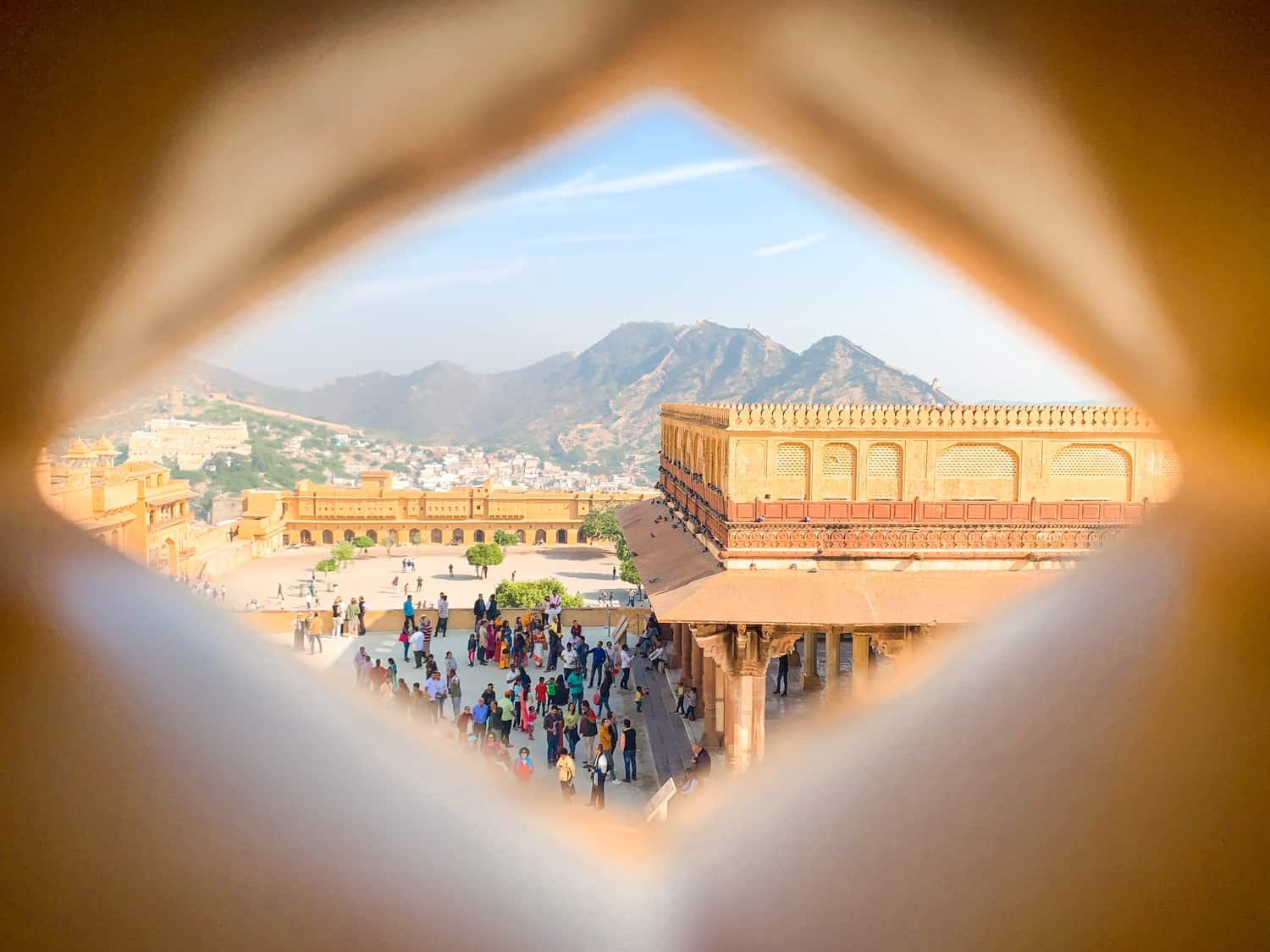
Where to Go After the Golden Triangle
I strenuously recommend seeing more in India than just the Golden Triangle.
While I loved my time there, I must confess that I fell for my next destinations in India so much more. India is an enormous country with so much more to offer than its three most popular cities, no matter how wonderful they are.
I travelled into Rajasthan after I finished up in Jaipur, visiting Bundi, Pushkar , Udaipur , Jodhpur, and Jaisalmer — I’d recommend visiting all five spots if you have the time, as they were all marvellous.
Other options include taking the train down to Mumbai to check out another Indian city that’s different to Delhi, Agra, and Jaipur. You could head to Varanasi. Goa is always a good option, and Kerala is beautiful. You could even head up into the mountains in the north.
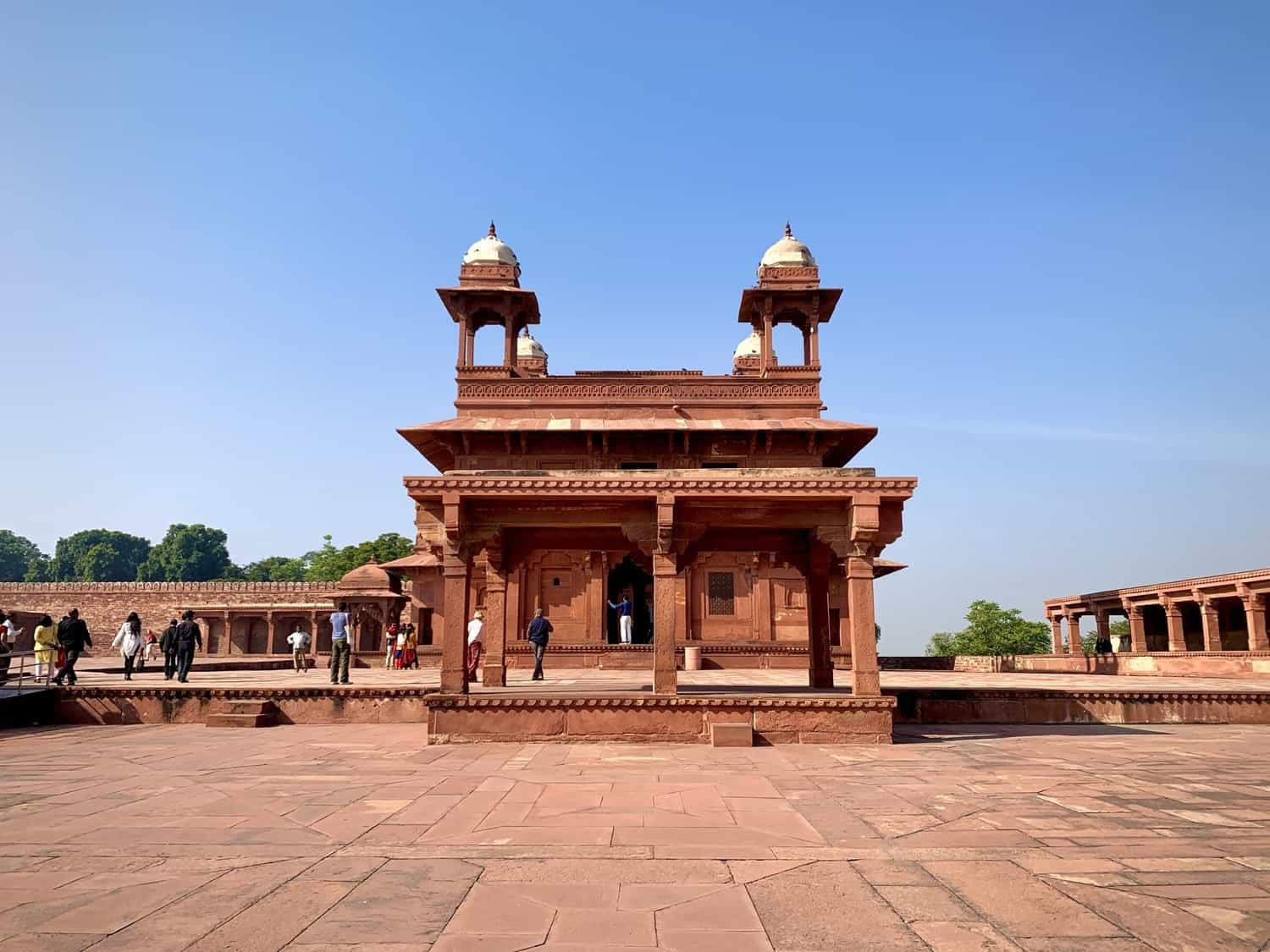
Yes, You Should Go to the Golden Triangle!
If you’re currently on the fence over whether you should visit or not, hopefully this guide convinced you that it’s more than worth visiting.
Give yourself enough time to see everything, and you’ll likely have a wonderful trip! Just make sure you don’t leave India immediately afterwards, because there’s so much more to see.
Related Articles on India 💰 The Cost of Travel in India: My Detailed Budget Breakdown 🇮🇳 12 Reasons Why I Absolutely Loved Rajasthan 💗 Three Perfect Days in Delhi: I Love This City So Much 🙅🏼♀️ How Not to Spend a Day in Jaipur 🤩 The Ultimate Guide to Visiting the Taj Mahal 🐪 Pushkar Travel Guide: 11 Things to Do in Pushkar 🤍 Yes, Udaipur is as Great as Everyone Says 🎶 I Went to a Pink Floyd-Themed Cafe in India
Lauren Juliff
Lauren Juliff is a published author and travel expert who founded Never Ending Footsteps in 2011. She has spent over 12 years travelling the world, sharing in-depth advice from more than 100 countries across six continents. Lauren's travel advice has been featured in publications like the BBC, Wall Street Journal, USA Today, and Cosmopolitan, and her work is read by 200,000 readers each month. Her travel memoir can be found in bookstores across the planet.
Related Posts

The Cost of Travel in South Korea: My 2024 Budget Breakdown

How to Spend Three Perfect Days in Delhi: An In-Depth Itinerary

Pushkar Travel Guide: 11 Things to Do in Pushkar
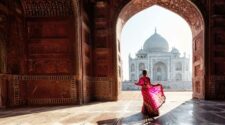
The Ultimate Guide to Visiting the Taj Mahal
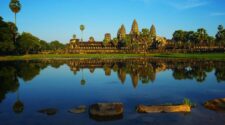
The Cost of Travel in Cambodia: A Detailed Budget Breakdown

How to Spend Two Weeks in Japan: An Itinerary for First-Time Visitors
Hey Lauren! Loved reading this amazing golden triangle guide. I know you didn’t enjoy it too much but Jaipur is my favourite of the three Golden Triangle cities.
Wow. That was a really impressive article. India has a very rich cultural heritage and history. All 3 cities you mentioned have their own identity. Like, Delhi is the Indian Political Hub, Jaipur has heritage forts and archaeological sites and Agra has “The Taj Mahal”. Thanks for your article and I can’t wait to see what you write next.
Thanks so much!
Incredible piece Lauren! I’m going to be heading to India next month – well, maybe not if the coronavirus has anything to do with it! But even so, when I do finally get to the Golden Triangle, this is the guide I’m going to be using! Thanks so much for putting all of this together for us.
Thanks for reading! And I hope you make it there, whether it’s next month or next year :-)
You have lovely photos of India!! They show how symmetrical and amazing their architectural structures are. Hope I can visit India someday too!
What a treasure trove of information. On my way to India in the next couple weeks. I will use your intel as a guide. Many thanks!
Hi Lauren, Thanks for the informative writeup. We were looking for information to help start planning our first short trip to India and found so many useful tips and advice from your article.
Leave a reply Cancel reply
Your email address will not be published. Required fields are marked *
- Perpetual Planet
- Environment
- Paid Content
- Photography
History & Culture
- History & Culture
- History Magazine
- Mind, Body, Wonder
- Adventures Everywhere
- Terms of Use
- Privacy Policy
- Your US State Privacy Rights
- Children's Online Privacy Policy
- Interest-Based Ads
- About Nielsen Measurement
- Do Not Sell or Share My Personal Information
- Nat Geo Home
- Attend a Live Event
- Book a Trip
- Inspire Your Kids
- Shop Nat Geo
- Visit the D.C. Museum
- Learn About Our Impact
- Support Our Mission
- Advertise With Us
- Customer Service
- Renew Subscription
- Manage Your Subscription
- Work at Nat Geo
- Sign Up for Our Newsletters
- Contribute to Protect the Planet
Copyright © 1996-2015 National Geographic Society Copyright © 2015-2024 National Geographic Partners, LLC. All rights reserved

- Meet the Team
- Work With Us
- Itineraries
- Italy Travel Guide
- Hawaii Travel Guide
- Travel Tips
7-Day Tour of the Golden Triangle in India
India is a colorful and vibrant country filled with unforgettable sights, vibrant colors, a rush of activity and sounds at all times, and amazing foods. It’s a great place for adventure, history, and cultural insights.
The Golden Triangle in India offers a way for visitors to immerse themselves in all of those things while seeing three of the country’s most-visited cities in the northwest.

The Golden Triangle gets its name from the geographical location of these three cities: Delhi, Agra and Jaipur, which form a triangle with about 200km between them.
The good news for travelers is that the Golden Triangle cities are all connected by good roads and trains, so it’s easy to get between them. Though India’s Golden Triangle is well connected, that doesn’t make it especially easy to plan a self-guided tour.
To make the planning process a little easier for you, we’ve created a 6-day Golden Triangle itinerary that includes all the top things to do, cities and sights to see on the Golden Triangle in India.
If you only have a week to spend in the north of India, this Golden Triangle itinerary covers as much ground as possible and gives a great overview of the region. If you have additional time to spend, we recommend adding on a few other stops along the way, which we’ll discuss below.
- Get a tour guide. It’s not super easy to get around India by yourself. A good tour company will plan everything for you and make sure you get around safely and easily. We recommend this 9-day tour with Kipling India Tours that adds culinary aspects to the historic sights you’ll see.
- There’s no one-size-fits-all travel insurance . Get a personalized quote from Yonder .
- The right luggage can make or break your trip. Check out these hard-sided suitcases .

Table of Contents
How to Plan the Ultimate Golden Triangle India Trip
When to visit the golden triangle.
Really, there is no “bad” time to visit the Golden Triangle in India. The considerations you need to make are all weather-related.
As with any other destination, there is a weather window that is the most pleasing in the Golden Triangle area. That time in the Golden Triangle is from October to mid-April, with temps ranging from 70-90°F.
We visited the area in January time and found it to be absolutely perfect weather for us. It wasn’t too hot or too cold. Since you’ll be walking around outside and depending on good weather for nice photos, it’s important that you’re comfortable.
You may have heard that the summers in India can be brutally hot. For this reason, we recommend avoiding the months of May and June, when the temperatures can reach as high as 115 degrees F.
The monsoon season is from July to September. Even though heavy rains generally only occur in bursts, it can put a damper on your tour plans.

How to Get to India’s Golden Triangle
The best way to get between the cities of the Golden Triangle – Delhi, Jaipur, and Agra – is by car. However, we do not recommend driving yourself around in India, if you’ve never driven there before.
Trust us when we say, the driving habits and rules are very different in India. The fastest, safest, and most economical way to travel around the Golden Triangle is by private driver.
We went with Kipling India Tours and it was perfect. The driver was very skilled and kept us safe, even in horrendous traffic. And they provide so much more than just a driver. More on that in a minute.
Rail travel in India has never been more comfortable with a choice of first- and second-class, air-conditioned cars. Prices are low so getting around India by rail is a good option. For example, the rail journey from Delhi to Agra is about 2 hours and costs the equivalent of around $20 USD.
Self-Guided or Planned Tour?
This is the first question you’ll have to answer when you start planning. I usually prefer to make my own self-guided itinerary and do all the planning myself.
However, for this itinerary, I highly recommend going on a guided tour , because planning a Golden Triangle tour on your own can be difficult and it’s not possible to drive yourself around to the sights.
–> A guided tour can be private or with a group. It’s actually quite cost effective to plan your own private guided tour of India. We did a 9-day culinary-focused tour of the Golden Triangle with Kipling and it was easy to customize to our liking, and we were fully in charge of our time and schedule.
Is India’s Golden Triangle Worth Visiting?
India’s Golden Triangle is definitely worth visiting. It gives you a rich experience of the country’s culture and history. The triangle includes Delhi, Agra, and Jaipur, taking you on a fascinating journey through these cities and their historical treasures.
What makes the Golden Triangle great is not just the amazing places but also how easy it is to explore. You can smoothly travel between these cities, each offering a different piece of India’s diverse landscape and friendly local hospitality.
While the Golden Triangle is a fantastic introduction to India, remember there’s so much more to explore beyond these three cities. It’s like a teaser that leaves you wanting to discover more of India’s incredible beauty and diversity.
Golden Triangle India Highlights
If you’d rather plan your own tour, you will need to hire a driver for the day to take you from place to place in each city.
The beauty of the Golden Triangle is that each destination has something special and unique to offer. So, lace up your favorite pair of travel shoes and prepare to create unforgettable memories in North India.
The northern region of India is an assorted mix of cultures, traditions, languages and arts. The vulnerability of this area to outside invaders throughout history has been both a blessing and a curse, bringing with the turmoil unique external influences and inspirations.
- Delhi – New Delhi, part of what is commonly referred to as just Delhi (yes, there is an Old Delhi), is the most ideal base from which to discover the marvels and wonders of India’s ancient subcontinent. Travel to New Delhi to discover India’s capital city, one of the oldest existing cities in the world.
- Jaipur – Not very far from Delhi is the state of Rajasthan, India’s land of maharajas and medieval forts and palaces. You’ll be visiting Jaipur, founded by the royal family that once ruled the region. In 1727, they founded what is now called the Pink City of Jaipur, due to the color of the buildings. Before you go, read about the best forts in Rajasthan and the Golden Triangle , many of which are included on this tour.
- Agra – The third city in the Golden Triangle is Agra, declared a UNESCO World Heritage site in 1983. Seldomly does anyone makes a trip to India and not visit Agra, where the Taj Mahal is located. Agra has much more to offer than just the Taj Mahal, though. Agra served as the capital of India from 1830s to 1860s and has a rich cultural heritage.
Each of these areas have their own unique traditions, histories, and delicious Indian foods you must try. That’s what makes this journey so fascinating. You’ll get to see and experience so many things.
Day 1-3: New Delhi
The capital of India, New Delhi, is a green, clean city with many famous tourist sights including the Lotus Temple, Jama Masjid, Red Fort, Qutub Minar, and the India Gate (reminiscent of the Parisian Arc de Triomphe).
The capital city of New Delhi, with its mix of four major religions, 7 reigns of power, and 2500 years of history, is a prime example of coexisting realities.

In Old Delhi, you’ll be surrounded by remnants of the Mughal Empire, including the largest mosque in India, the Jama Masjid, and Humayun’s Tomb, a 16th-century landmark of breathtaking Mughal architecture that would later be echoed in the Taj Mahal.
New Delhi is almost a different world with its imperial architecture and broad stately boulevards. Colonial influence is abundant since the British declared Delhi the capital during their rule.
What to See & Do in New Delhi:
- The Red Fort
- Jama Masjid (the largest mosque in India – pictured above)
- Qutab Minar complex with its soaring tower
- Humayun’s Tomb
- Eat at Indian Accent (unique modern take on north Indian cuisine)
- Take a cooking class

On our culinary tour with Kipling India, we had the opportunity to take a cooking class with Ms. Neha at Saffron Palate . She taught us to cook four dishes in the kitchen annex of your Delhi home. Being the food lovers that we are, this was a highlight of our time in Delhi.
Day 4-6: Jaipur

Built in the year 1727 AD by Maharaja Sawai Jai Singh II, Jaipur is architecturally rich. The only planned city of its time, it has many attractive monuments. You’ll need a few days to see all the things in Jaipur that we’ve listed below.
Keep in mind that it’s a 6-hour drive to Jaipur from Delhi so most of one day will be spent on the transfer.
Things to See in Jaipur:
The amber fort.
The town of Amer and the Amber Fort were originally built by the Meenas, but it was later ruled by Raja Man Singh I. The Fort, also a palace, is the most visited sight in Jaipur and it’s easy to see why when you arrive at the fort on the hill. The fort is very impressive with its large ramparts and series of gates and cobbled paths.
The interior is even more stunning. This is where the Maharaja and his many wives lived. It is opulent and massive. The fort was declared a UNESCO World Heritage site in 2013.
The City Palace
The former royal palace showcases Rajasthan and Mughal styles. It houses a museum with a collection of costumes and armour of Rajasthan’s Mughals and Rajputs. It also has an art gallery with excellent collections of miniature paintings, carpets, royal paraphernalia.
The City Palace is no longer a royal residence, but it hosts events and is open to the public for visiting.

Jantar Mantar
Largest of Jai Singh’s five observatories, this stone structure houses scientifically designed complex instruments that helped advance Indian astronomy in medieval times. They still work perfectly in the modern era.
Hawa Mahal (Wind Palace)
This five-storey structure along the main street of the old city was originally built to enable royal women to watch the everyday life and royal processions of the city.

Govind Devji Temple
Located in the central pavilion of the Jai Niwas Garden, this spireless temple is dedicated to Lord Krishna. The image of the patron deity Govind Devji originally installed in a temple in Vrindavan was reinstalled by Sawai Jai Singh II as his family deity.
Known as the Water Palace, the Jal Mahal is located in the middle of Man Sagar Lake. Although you can’t visit the palace, you can see it from the street and it makes you want to be out there lounging on a chair in the sun.

Jaipur Food Tour
One of the great culinary activities we did in Jaipur with Kipling India Tours was a food walk of the downtown area in Jaipur. Our guide introduced us to all kinds of great foods, like kachori, chaats, lassi, and jalebi from Laxmi Misthan Bhandar, one of the oldest and most prestigious sweet shop of Jaipur.
Day 7-8: Agra
The Taj Mahal in Agra is of course one of the must-see sights in India. It took 20,000 laborers to build the Taj Mahal in the 1600s and has become a known landmark throughout the world.
You can feasibly visit the Taj Mahal from Delhi in just one day, but you’d miss out on the other sights to see in Agra. We recommend spending 2 days in the city to get a good overview.
Things to See in Agra

Agra Fort is an impressive 16th-century fortress. It was the primary residence of the emperors of the Mughal Dynasty up until 1638 when the capital of India was moved from Agra to Delhi. Also used by the military to this day, part of Agra Fort was converted into a lavish palace by Shah Jahan.
Inside the complex, there are several mosques, including the beautiful Nagina Masjid, originally used by the ladies of the court. You will also see the Mirror Palace where Shah Jahan was imprisoned for eight years by his son.

Taj Mahal, the symbol of eternal love for the beloved, is undeniably the most fascinating piece of craftsmanship in India. This architectural gem is not just the most treasured monument in the country, but this UNESCO World Heritage Site has also been enlisted as one of the new “Seven Wonders of the World”.
Covered in white marble, this marvelous mausoleum is known for its unparalleled architectural design and mesmerizing backdrop. It’s by far the most photographed building in India. For photos, the best times to visit are at sunrise and sunset. Taj Mahal opens its gates 30 minutes before sunrise and shuts down 30 minutes before sunset.
It remains closed on Fridays. Tickets are available at the ticket booth up to 45 minutes before the sunset. You can also buy tickets online. If you’re visiting on a guided tour, your tour guide will purchase the tickets for you.
>> Read more about visiting the Taj Mahal
The Baby Taj
The building often called the Baby Taj, Itimad-ud-Daulah, is a lavish 17th mausoleum for Mirza Ghiyas Beg and his family. It was the first building in the city to be covered entirely in marble, having been built before the Taj Mahal. It’s quite a bit smaller than the Taj Mahal, but its design is also incredibly lavish and detailed.

Agra Food Tour

Our tour with Kipling India Tours included a food walk of the downtown area in Agra. Even though we’d already tried so many things in Jaipur, we found that the street food in Agra was quite a bit different. There were many foods to try in Agra. Our favorite of the stops was at a local chicken place called Mama Franky.
Our guide assured us that his family eats at Mama Franky often and it’s a local favorite. Everything we ate there was delicious.
Where to Stay
When visiting India’s Golden Triangle, you can find various overnight accommodation options to suit your preferences and budget. In each city—Delhi, Agra, and Jaipur—there are choices ranging from budget-friendly to more luxurious stays.
In Delhi, you’ll find a wide range of hotels, guesthouses, and budget-friendly hostels. Popular areas to stay include Connaught Place, Karol Bagh, and Paharganj. These areas offer easy access to attractions and transportation.
Agra has hotels for different budgets, and many are located near the Taj Mahal. Taj Ganj is a popular area for accommodation, providing a view of the iconic monument. There are also options near Agra Fort and the city center.
Jaipur offers a mix of heritage hotels and modern accommodations. Areas like Pink City (Old Jaipur), Bani Park, and MI Road have a variety of hotels. Staying in the Pink City allows you to be close to the major attractions.
When choosing where to stay, consider factors like proximity to the attractions you plan to visit, your budget, and the type of experience you want.
Frequently Asked Questions on Visiting India’s Golden Triangle
How is the transportation between these cities.
Transport is usually by road. You can hire a private car with a driver or join a guided tour that provides transportation between the cities. There are also train options available.
Is the Taj Mahal open every day?
The Taj Mahal is open every day except Fridays. It is advisable to check for any specific holiday closures or special events before planning your visit.
What is the best time to visit the Golden Triangle?
The best time to visit the Golden Triangle is during the winter months (October to March) when the weather is pleasant. Summers (April to June) can be extremely hot, while the monsoon season (July to September) brings heavy rains.
Is it safe to travel in the Golden Triangle?
Generally, the Golden Triangle is considered safe for tourists. However, it’s essential to take standard precautions like safeguarding your belongings and being aware of your surroundings. Follow local guidelines and advice for a safe and enjoyable Golden Triangle trip.
What are the prominent forts to explore in the Golden Triangle?
The Golden Triangle boasts several impressive forts. In Delhi, visit the Red Fort; in Agra, explore Agra Fort, and in Jaipur, don’t miss the grand Amber Fort.
Final Thoughts
India is a fascinating place to visit. If we can guarantee anything, it’s that your time in this country will stay with you forever. If you have at least 7-days in India, you can experience so much and see the major sights of the Golden Triangle.
Yes, it’s only a small piece of what India has to offer, but then you can start planning your return trip. All that’s left to do is pack your luggage , book your flight, and reserve your tour tickets. Get ready to indulge in the diverse flavors, sights, and experiences that the vibrant country has to offer.
Pin it for later!

Laura Lynch, creator and writer of Savored Journeys, is an avid world traveler, certified wine expert, and international food specialist. She has written about travel and food for over 20 years and has visited over 75 countries. Her work has been published in numerous guidebooks, websites, and magazines.
6 thoughts on “ 7-Day Tour of the Golden Triangle in India ”
Hii, Thanks for sharing this article with us . You have given very good information about all the places . it’s very useful article . keep it up .
Wonderful Post!! I read you post it is very helpful. India food very delicious, I plan to visit Golden Triangle circuit such as a really incredible destination. Can I visit Ranthambore national park along Delhi-Agra-Jaipur, how many days are required to cover this beautiful destinations.
You can visit Ranthambore National Park on this Golden Triangle Tour but be sure to add at least 2 days to see it properly. To see just an overview of the area will take at least 7 days, but better with 2 weeks time.
I have enjoyed the Golden Triangle with an amazing Guide. Bhanwar Hada Singh, if you get a chance to choose your guide, I highly recommend him. He was enthusiastic, and very knowledgeable about this incredible area. Bhanwar was liked by all the age groups on my trip, from 20’s to late 70’s.
Thanks for this article! I’ve only been to India once, on my honeymoon in Goa. It was so wonderful! We rented a luxury villa and watched the beautiful sunsets.
That sounds lovely, Kevin.
Leave a Reply Cancel reply
Your email address will not be published. Required fields are marked *
Save my name, email, and website in this browser for the next time I comment.
- Travel Resources
Early booking offers ending in
CALL US FREE ON 01695 577 961
Open Again Monday
Classic escorted tours.
- 11-day The Golden Triangle & Ranthambore Tour
- 14-day Golden Triangle & Goa Tour
- 14-day Splendours of Kerala Tour
- NEW! 17-day Indian Wildlife Adventure Tour
- NEW! 19-day The Very Best of Southern India Tour
- 25-day Grand Tour of India
- 13-day Temples & Tigers Tour
- NEW! 16-day Highlights of Southern India Tour
- 17-day Temples, Tigers & Goa Tour
Private Tours
- NEW! 14-day Deccan Odyssey’s Grand Heritage Tour
- NEW! 15-day Deccan Odyssey’s Cultural Discovery Tour
River Cruise
- NEW! 17-day The Brahmaputra River & Darjeeling Tour
- 17-day The Very Best of Sri Lanka Tour
- NEW! 14-day Treasures of Sri Lanka Tour
Holiday Extension
- 3-night Sri Lanka Beach Stay
- 19-day Essential Australia Tour
- 22-day Wonders of Australia Tour
- 26-day Christmas & New Year in Australia Tour
- NEW! 27-day Australia’s East Coast Jewels
- 29-day Treasures of Australia Tour
- 29-day The Very Best of Australia Tour
- 24-day Magnificent New Zealand Tour
- 24-day Natural Wonders of New Zealand Tour
- 27-day New Zealand by Rail, Road and Sea Tour
- 28-day The Very Best of New Zealand Tour
- 31-day Highlights of Australia & New Zealand Tour
Combination Tours
- 44-day to 61-day Australia & New Zealand Combination Tours
- 20-day The Very Best of Japan Tour
- 23-day The Very Best of China Tour
- NEW! 15-day Classic Vietnam & Cambodia Tour
- 15-day Highlights of Vietnam Tour
- 22-day The Very Best of Vietnam & Cambodia Tour
- NEW! 18-day Discover Vietnam & Cambodia
- 3-night Mekong Delta
- NEW! 3-night Luang Prabang, Laos
Vietnam & Cambodia
- 14-day Grand Canadian Rockies Tour
- 21-day Grand Canadian Rockies & Alaskan Cruise Tour
Holiday Extensions
- 4-night Knight Inlet Tour
- 18-day Spectacular South Africa Tour
- 18-day Spectacular South Africa including Rovos Rail
- 25-day The Very Best of South Africa Tour
- 17-day African Rail Adventure
- NEW! 17-day Namibian Rail Safari
- NEW! 17-day South African Rail Discovery
Small Group Safari
- NEW! 13-day In Search of the Big Five
- 3-night Cape Town Tour
- 3-night Victoria Falls Tour
- 3-night Chobe National Park Tour
- 6-night Victoria Falls & Chobe National Park Tour
New Zealand
Australia & new zealand, canada & alaska, south africa.
- 17-day African Rail Adventure Tour
- NEW! 17-day Namibian Rail Safari Tour
- NEW! 17-day South African Rail Discovery Tour
- 18-day Spectacular South Africa including Rovos Rail Tour
- 25-day Very Best of South Africa Tour
- NEW! 17-day The Brahmaputra River & Darjeeling
- NEW! 18-day Discover Vietnam & Cambodia Tour
- Private Tours of China
- Private Tours of India
- Private Tours of Sri Lanka
- Private Tours of Vietnam & Cambodia
It’s Your Time to Explore
It’s hard to sum up everything you’ll experience on a Distant Journeys holiday, but here we’ve tried to inspire you. With who you will become, what you will discover and, most importantly, the memories you will treasure forever. It’s Your Time to become…
- an Adventurer
- a Historian
- a Storyteller
10 Year Anniversary
We are celebrating 10 years of Distant Journeys. Since 2014, we have been designing and delivering an exciting style of touring holiday that meets exceptional standards and offers unbelievable value. Operated at a leisurely pace and providing unrivalled flexibility, our itineraries are perfectly tailored to the tastes of UK travellers.
- Find out more
- Escorted Touring Experience
- Holiday Styles to Suit You
- So Much Included
- Freedom & Flexibility
- Once in a Lifetime Experiences
- Hand-Picked Hotels
- Freedom to Explore
- Travelling with Distant Journeys
- Award-Winning Customer Service
- Meet the Distant Journeys Team
- Tour Managers, Guides & Coach Captains
- Refer a Friend
- Customer Reviews
- Financial Security
- Price Promise
- Special Offers
- REQUEST A BROCHURE
- CALL FREE 01695 577 961
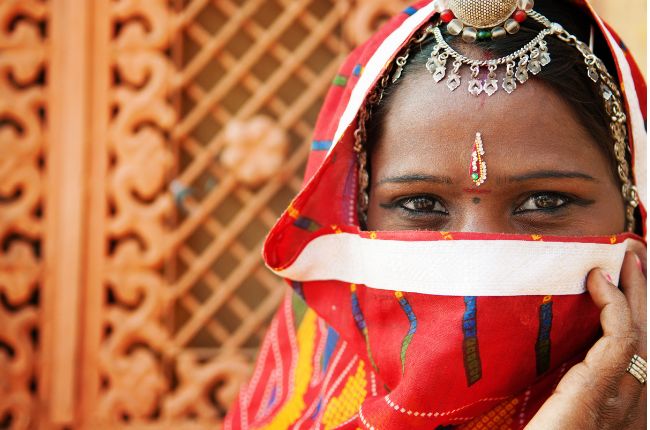
Golden Triangle Guide | India’s Golden Triangle

India’s Golden Triangle is a 3-stop tour, available as part of our India tours , that incorporates the beautiful cities of Delhi, Agra and Jaipur. The Golden Triangle is a great way to experience some of India’s most impressive cultural gems. Enjoy a fascinating rickshaw ride through Old Delhi, marvel at the impressive Agra Fort built in the 1500s, and immerse yourself in the magnificent sights of picturesque Pink City.
In this guide, we take a look at everything you need to know ahead of visiting the Golden Triangle, including how long it takes to explore and the must-see sights during your trip.
What is the Golden Triangle?
The Golden Triangle is a popular tourist route in India that connects the cities of Delhi, Agra, Ranthambore and Jaipur. Spanning multiple states, the Golden Triangle is a great way to get acquainted with the varying cultures and customs of north India.
Each city on the tour has its own unique story to tell. Marvel at architectural masterpieces and faded opulence as you enjoy a heritage tour of India’s Golden Triangle. One thing’s for sure, you’ll never be short of impressive sights to behold.
How long does it take to do the Golden Triangle?
There are many highlights to see on a tour of the Golden Triangle, you can experience everything during an 11-day trip. At Distant Journeys, we have expertly crafted our tours so that you can experience all that the Golden Triangle has to offer – in the perfect amount of time!
Our 11-day tour of The Golden Triangle & Ranthambore was designed to give travellers 9 impressive days exploring the Golden Triangle, complete with a trip to Ranthambore. While our 14-day Golden Triangle & Goa tour boasts a similar time frame in The Golden Triangle, followed by a relaxing retreat in Goa.
Highlights not to miss on a Golden Triangle holiday
If you choose to explore the Golden Triangle with us, we’ll experience all that this beautiful region has to offer. Here are a few trip highlights.
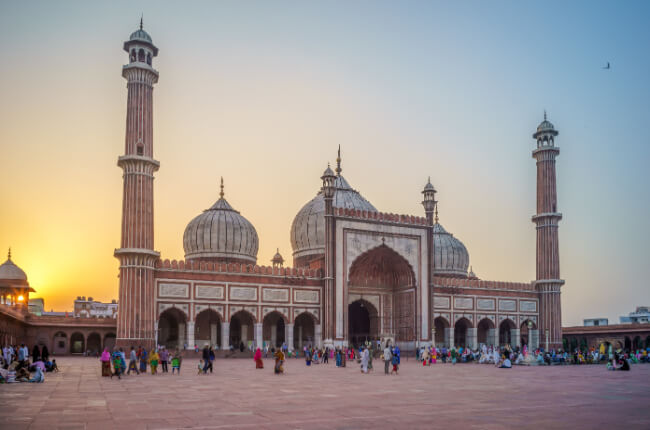
Deli is the home of India’s national government and is a city of great historical significance. It was once home to the Mughal emperors and still, to this day, many of its historical monuments are still intact. Delhi also offers a lively atmosphere, with plenty of great street food options across the city.
Our trip highlights include:
The Red Fort – An opulent palace from the Mughal Empire.
Jama Masjid – One of the largest mosques in India.
Chandni Chowk – Delhi’s impressive wholesale market.
India Gate & Parliament House – The seat of parliament.
Qutub Minar – A 72.5 metre tall victory tower.
Humayun’s Tomb – The first garden-tomb on the Indian subcontinent.
Gatimaan Express to Agra – Finally, board India’s historic and first semi-high-speed train as we journey to Agra.
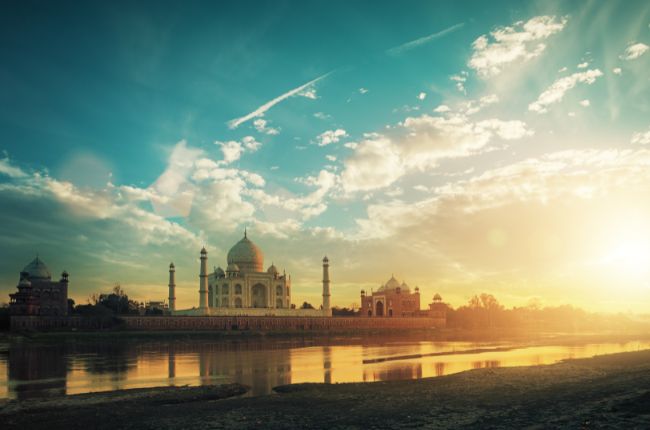
Agra is a city famous for its Mughal architecture, but it’s perhaps best known for being home to one of the Seven Wonders of the World – the distinguished Taj Mahal.
Agra’s highlights include:
Agra Fort – Our first stop in the city is this historical fort that was once the main resilience of the Mughal emperors.
Taj Mahal – This one certainly needs an explanation. Join us as we take in this breath-taking masterpiece at sunset.
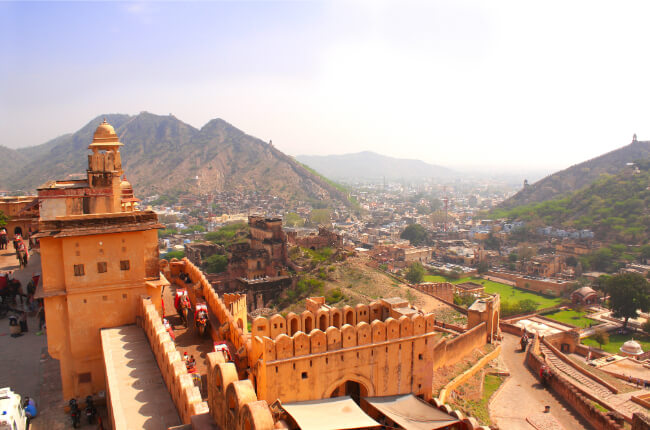
Jaipur is the largest city within the Indian state of Rajasthan. It’s commonly referred to as The Pink City thanks to its brightly coloured architecture. Jaipur is home to some impressive sights, including a UNESCO World Heritage Site.
Jaipur’s highlights include:
City Palace – Established at the same time as the city of Jaipur, the City Palace represents a blend of Rajput and Mughal architecture.
Amber Fort – An impressively artistic fort overlooking Maota Lake. The fort holds prestigious UNESCO World Heritage status.
Jantar Mantar – This astronomical observatory is thought to have been built by the enlightened ruler Sawai Jai Singh II in 1729.
Hawa Mahal – An impressive pink sandstone palace that was completed in 1799.
Traverse the Golden Triangle with Distant Journeys
Ready to explore all 3 corners of the Golden Triangle? From Delhi to Agra, journeying on to Jaipur, and exploring Ranthambore National Park, The Golden Triangle is undoubtedly one of the best ways to experience the many flavours of India.
Take a tour of the Golden Triangle with us and we’ll encounter many amazing experiences throughout our trip – and in the perfect amount of time.
Our local tour guides, and expert tour managers, are here to make your trip to the Golden Triangle a memorable one. If you’re ready to see the sights, explore our India tours and Golden Triangle holidays to get started.

BROCHURE REQUEST
Order your free brochure
BOOK WITH CONFIDENCE
Award-winning holidays.
Distant Journeys has won 18 awards over the last seven years, at the British Travel Awards, and we have been awarded Feefo’s highest Platinum Trusted Rating for customer satisfaction.
Guaranteed Price Promise
Know you are paying the best price for your holiday with our Price Promise. We never offer last minute discounts and we guarantee the earlier you book the better the offer you’ll receive.
100% Financial Protection
Book in the confidence your money is 100% safe. All Distant Journeys holidays are fully bonded by the Civil Aviation Authority (ATOL number 10913) or ABTOT (number 5427).
ORDER YOUR BROCHURES TODAY
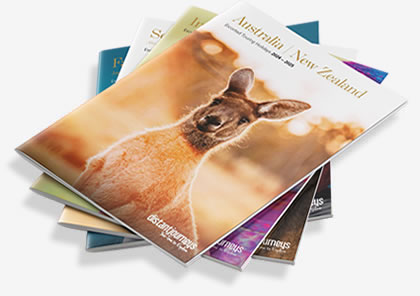
Planning your next holiday? Let Distant Journeys give you some travel inspiration.
There are three easy ways to request your brochures – just click on your preferred option below:
CUSTOMER REVIEWS

Receive News & Offers from Distant Journeys
In accordance with the latest GDPR data regulations, you can unsubscribe from our emails at any time. You can read our privacy policy that provides further information about how we use personal data.

Perfect Pairs
">Distant Journeys offer a number of combination tours that allow you to explore two countries in one.. Read More
Celebrating 10 years of Distant Journeys
">A special anniversary... This month we are celebrating 10 years of Distant Journeys. Since 2014, we.. Read More
DESTINATIONS
- Canada & Alaska Tours
- Australia Escorted Tours
- New Zealand Escorted Tours
- Australia & New Zealand Escorted Tours
- South Africa Escorted Tours
- India Escorted Tours
- Sri Lanka Escorted Tours
- Japan Escorted Tours
- China Escorted Tours
- Vietnam & Cambodia Escorted Tours
HELPFUL LINKS
- Distant Journeys Official Blog
- Manage My Booking
- Environmental Policy
- Cookies / Privacy
- Booking Conditions
CONTACT INFORMATION
Distant Journeys, 8 Hattersley Court, Ormskirk, Lancashire, L39 2AY
Email: [email protected]
Distant Journeys - Copyright 2024.

Destinations

Travel Types
Land journey, ocean cruise, rail journey, river cruise, tailor made journeys.
- Inspiration
- Why Travel With Us
Travel agent
Tour personaliser.
- 1300 208 712
Find your next trip
Canada, alaska and usa, new zealand, about travelmarvel, travel insider magazine, why travel with us, enhance your journey, authentic flavours, premium accommodation, insider experiences, book with confidence, traveller club, accreditations, responsible tourism, travel information, travel agent, travelmarvel, india’s golden triangle, tigers and shimla, delhi return.
- Check Availability & Book Now
- Travel & Accommodation
Map & Itinerary
Similar trips, trip inclusions.
- 12 nights in premium accommodation
- Services of a Great Rail Journeys Tour Escort
- 30 meals – 12 breakfasts, 6 lunches and 12 dinners
- Ride the legendary Toy Train to Shimla, nestled at the foothills of the Himalayas
- Enjoy an informative talk from an author, historian and journalist Raaja Bhasin on the history of Shimla
- Take a fascinating rickshaw tour in Old Delhi and explore the Pink City of Jaipur
- Search for the elusive tiger on morning and afternoon game drives in Ranthambore National Park
- Experience the mighty Amber Fort with its ornate rooms and Mughal architecture
- Itinerary operated by Great Rail Journeys
- Itinerary, inclusions and pricing are subject to change
- Prices include transfers, tipping and porterage
- When arriving in Delhi, ensure your flight lands before 4pm
- Prices are for land/rail only. Flights not included unless specified
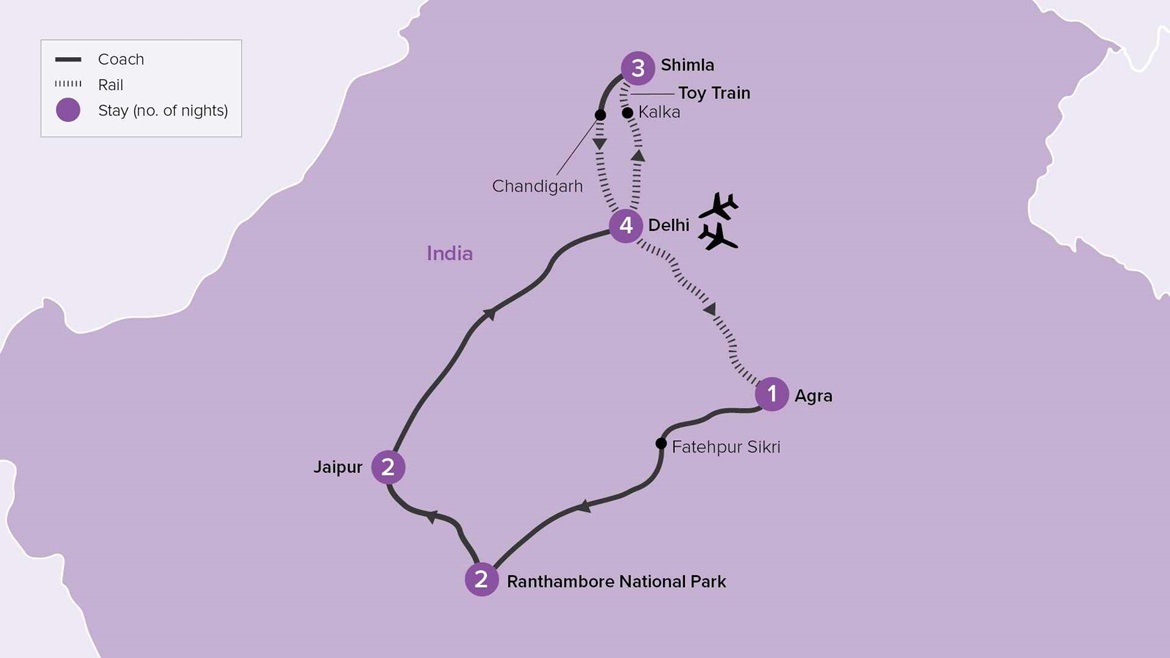
Designed exclusively for our guests
Insider Experience
Enjoy an included special or unique excursion or event
Arrive Delhi
Arrive in Delhi, the vibrant capital city of India, which seamlessly blends tradition and modernity. Be met on arrival and transferred to your hotel. Perhaps explore the local area and take in the kaleidoscope of sights, sounds and flavours on offer. Tonight, get to know your Great Rail Journeys Tour Escort and fellow travellers during a Welcome Dinner.
Stay: Delhi, Taj Palace
Delhi, Shimla
Insider experience.
Ride the legendary ‘Toy Train’ to Shimla. The World Heritage Toy Train provides one of the country’s most idyllic train journeys. This vintage train chugs its way up a winding route through the Shivalik Hills, passing lush green countryside, tree-covered valleys, across hundreds of bridges and traverse 102 tunnels.
This morning, transfer to New Delhi for your journey to Kalka in the foothills of the Himalayas. From your seats in your AC Chair Class carriages on the Shatabdi Express, enjoying a picnic lunch at your seats. From here, you’ll embark on your Insider Experience and board the Toy Train to Shimla, once the summer capital of the British Raj, arriving by early evening. Enjoy dinner with fellow guests tonight at your historic 5-star hotel.
Stay: Three Nights, Shimla, The Oberoi Cecil

Enjoy a talk from author, historian and journalist Raaja Bhasin as he presents an informative talk full of spellbinding stories about his hometown as he brings to life the history of Shimla.
After breakfast today, enjoy your fascinating Insider Experience then embark on a guided sightseeing tour of Shimla and see a number of colonial sights including the Viceregal Lodge, once the summer residence of the Indian viceroys and the Gaiety Theatre. Continue to the Sankat Mochan Temple before an afternoon stroll past the Victorian-Gothic Christ Church and to the mysterious Scandal Point, once popular for people to gather and share gossip. Later enjoy dinner at the hotel.
Nestled at the foothills of the Himalayas and surrounded by picturesque natural scenery, Shimla is a delight to visit and was a favourite with the Sahibs from the time of the Raj. Make the most of your free day in this charming town as you further discover on your own. Perhaps explore the Himalayas outside Shimla or visit Wildflower Hall for an indulgent high tea. Later this evening meet for dinner.
Shimla, Delhi
After breakfast, travel from Shimla to Chandigarh by road, navigating the twisting route amid incredible scenery of verdant valleys, before boarding the Shatabdi Express train back to Delhi, with a simple picnic lunch at your seat. Upon arrival, transfer back to your hotel and spend some time at leisure before regrouping for dinner.
Stay: Two Nights, Delhi, Taj Palace
Take a rickshaw ride through the narrow streets of Old Delhi’s lively Chandni Chowk bazaar.
Today you will explore Delhi, India’s vibrant, hectic, awe-inspiring capital city. Visit Jama Masjid, a 17th-century mosque, and India’s largest. Sit back and enjoy your Insider Experience. There is free time to enjoy lunch before embarking on a sightseeing tour of New Delhi. See India Gate, a triumphal arch commemorating Indian soldiers killed during the First World War. At the other end of this magnificent boulevard is Rashtrapati Bhavan, the official residence of India’s president, built in a blend of Mughal and European architecture. After a visit to the opulent 16th-century tomb of Mughal emperor Humayun, conclude your tour at the Gandhi Smriti Museum. Learn about the life of Mahatma Ghandi, the man who Indians call the ‘Father of the Nation’ through informative artefacts and personal effects.
Delhi, Agra
Be in awe at the beauty of the iconic Taj Mahal, the white marble mausoleum inlaid with semiprecious stones. Commissioned in 1631 by the fifth Mughal emperor to house the tomb of his beloved wife Mumtaz Mahal. It also houses the tomb of Shah Jahan himself. The structure took over 22 years to build and is a wonder to behold. Its awe-inspiring glittering white marble domes almost seem to change colours throughout the day depending on the position of the sun.
Set off this morning to the station where you will board the Gatimaan Express, travelling from Delhi to Agra, a journey that takes just over an hour and a half, on India's first semi high-speed train and the fastest train in India. Enjoy simple Indian snacks as you relax in fully air-conditioned carriages and enjoy the passing scenery. Once in Agra, embark on your Insider Experience and later a sightseeing tour of the World Heritage-listed Agra Fort. One of the city’s most historic sites, the fort has served as both a military point and a royal residence in the past.
Stay: Agra, Hotel Clarks Shiraz

Agra, Fatehpur Sikri, Ranthambore National Park
Indulge in a traditional lunch of Rajasthani cuisine at the opulent Laxmi Palace Vilas, which was built in the 1850s as a home for a prince of the Kingdom of Bharatpur.
Transfer from Agra to Ranthambore National Park, stopping en route at the abandoned ancient city of Fatehpur Sikri, a World Heritage- site, for a guided tour. This town to the west of Agra was once known as the City of Victory. Built in the 16th century, Fatehpur Sikri is home to a number of impressive monuments and temples. Enjoy your Insider Experience before jumping back into your coach for the last leg of your trip to Ranthambore National Park. Dinner is at your hotel.
Stay: Two Nights, Ranthambore Regency
Ranthambore National Park
This morning, enjoy hearing a local naturalist deliver a lecture on Ranthambore National Park.
Enjoy a morning Insider Experience. After lunch, head out for a guided game drive in canters, an open topped safari vehicle, through the national park and go in search of the Bengal tiger. Ranthambore is one of the best parks to view this elusive cat, so make sure to have your camera at the ready. After an afternoon of exploration, return to your hotel for dinner.
Ranthambore National Park, Jaipur
Witness an evening Aarti, a mesmerising Hindu fire ritual accompanied by lively singing and dancing, offered as part of a temple blessing.
This morning set out on an early morning safari, the best time of day to see native wildlife, such as sloth bears, macaques, wild boar and leopards and perhaps have a chance of seeing an elusive Bengal tiger. Afterwards, return to your hotel for breakfast then travel by coach to Jaipur. Visit Birla Temple for your Insider Experience en route to your premium accommodation in the Pink City of Jaipur.
Stay: Two Nights, Jaipur, Taj Amer
Explore the Pink City of Jaipur a pink tuk tuk. This enjoyable mode of transport is part of a social enterprise project to provide the city’s women with the opportunity for their own livelihoods. Discover why it's beautiful buildings are coloured in a distinctive hue.
Begin the day with a visit to the City Palace, a gorgeous 17th-century palace blending decorative Mughal and Rajput architecture and home to the current Maharaja, before travelling to the UNESCO-listed Jantar Mantar, an early 18th-century astronomical observatory. View one of Jaipur’s most renowned sights is the Hawa Mahal, the Palace of the Winds. The eastern facade of this pink and yellow sandstone structure is incredibly ornate. Five storeys of intricate lattice work dotted with 953 small windows. After our tour, enjoy your special Insider Experience. The rest of the day is free to spend at leisure and you can either unwind at our hotel or explore Jaipur’s excellent shopping optons.

Jaipur, Delhi
Spend time touring through the Amber Fort, learning about its fascinating history and uncover many of the rooms elaborately painted with decadent mirrors and precious stones.
Travel by jeep for your Insider Experience. This afternoon, close the sides of the Golden Triangle as you are transferred by coach back to Delhi. Tonight, say goodbye to your fellow travellers at a Farewell Dinner.
Depart Delhi
After breakfast, you’ll be transferred to Indira Gandhi International Airport for your flight.
Everything was wonderful. There were great sight seeing trips and the guides were very knowledgeable.
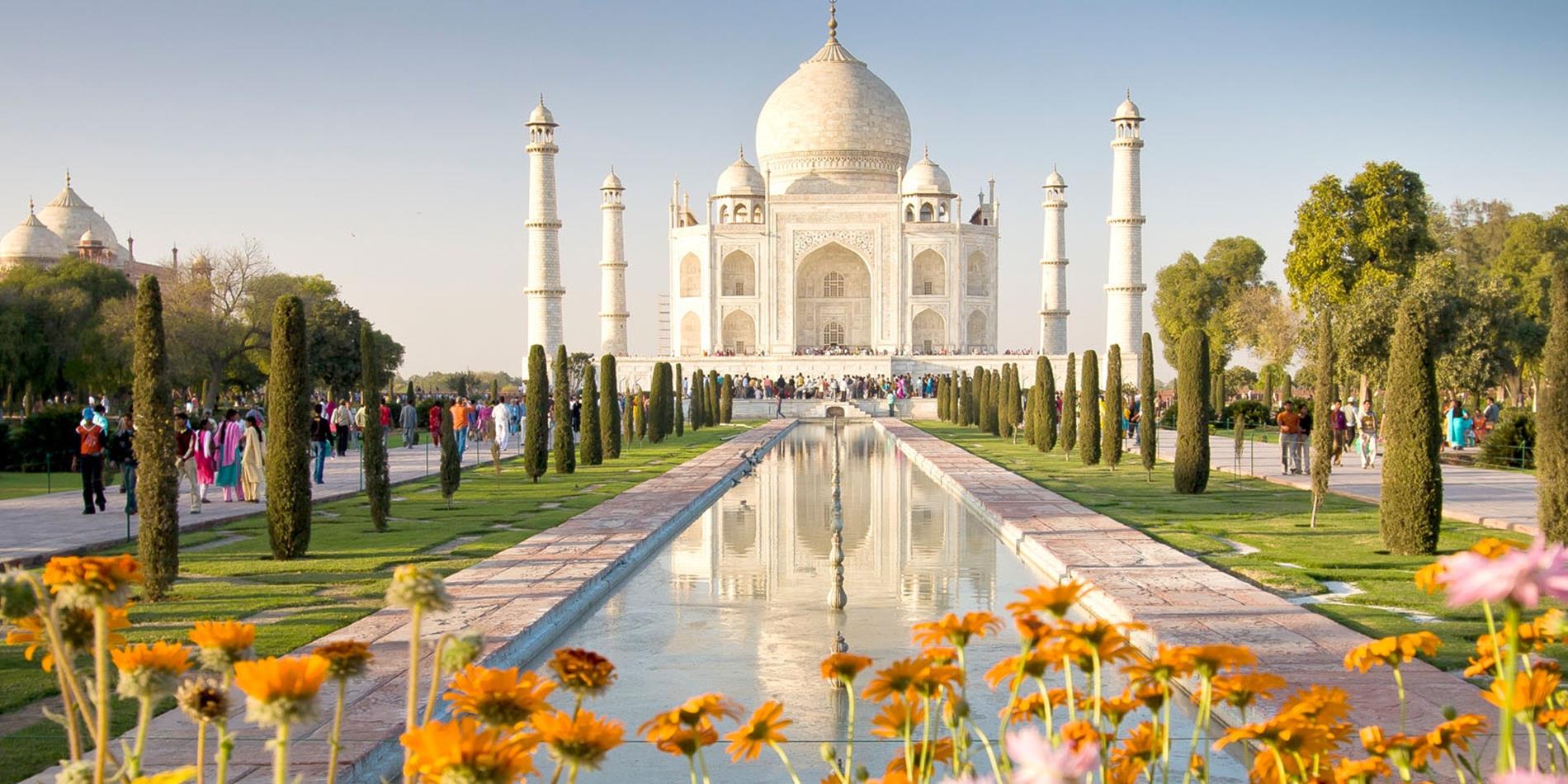
Highlights of the Golden Triangle and Mumbai
Delhi to Mumbai
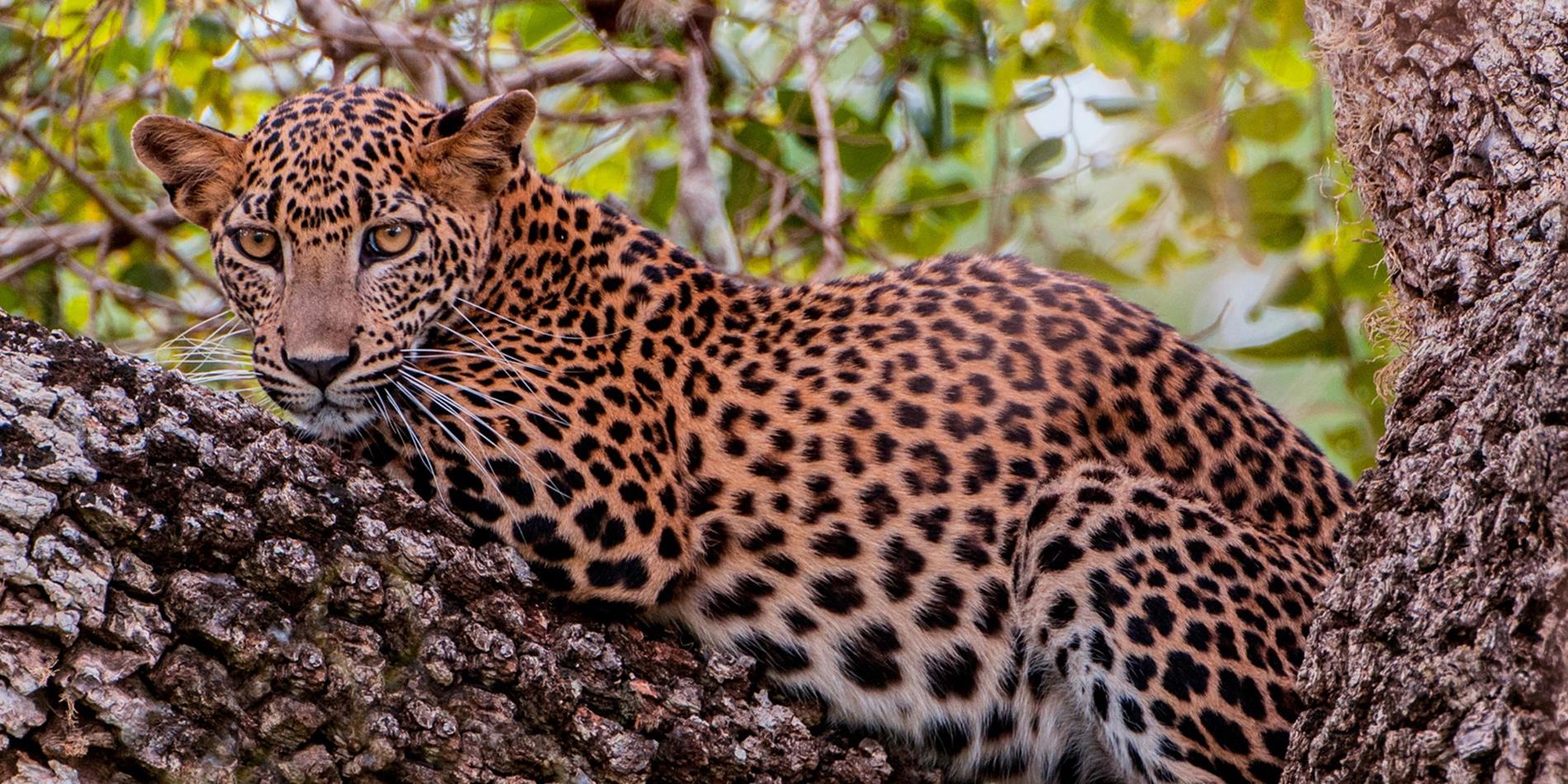
In Search of Tigers and Leopards
Delhi to Colombo
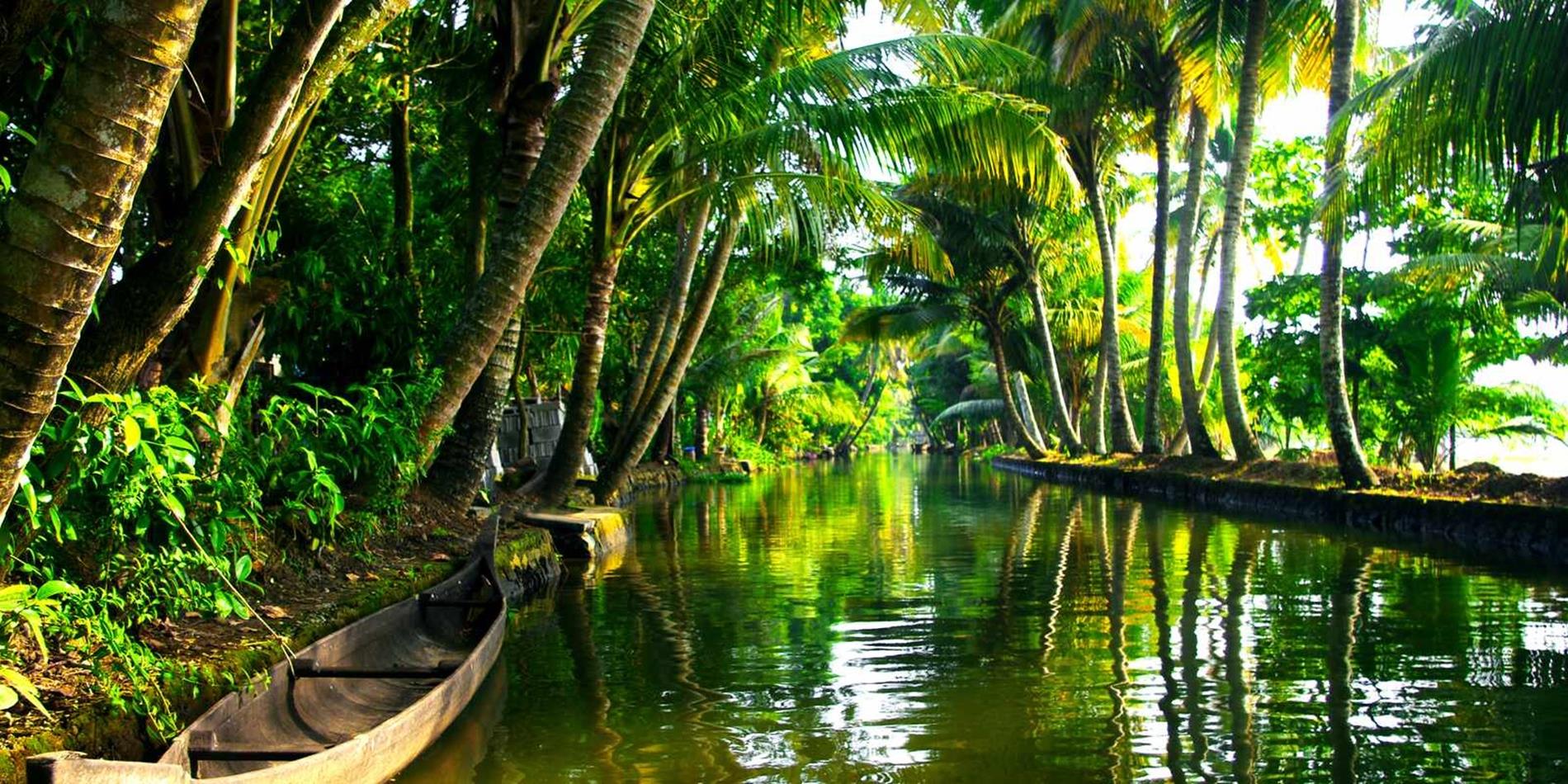
Discover Southern India and Kerala
Bengaluru to Chennai

IMAGES
VIDEO
COMMENTS
About the tour. Follow in the regal footsteps of maharajas and emperors to experience the dazzling wonders of India's majestic Golden Triangle with the experts in Indian rail travel. On our best-selling tour, we view astounding palaces including the iconic Taj Mahal and the ethereal Amber Fort, as well as the former home of 'Father of the ...
You'll explore Delhi in all its vibrant winder, and you'll visit historically important landmarks like the Taj Mahal. Relax as the Maharaja's Express takes you from town to city in this magical part of India, introducing you to the cuisine and the people of this wondrous country. Request a quote. Call for quote 01904 521 936.
Take the journey of a lifetime as you step back in time to the golden age of travel, when you board the luxurious Deccan Odyssey train. Your adventure begins in Delhi where you'll explore the city, before boarding this vintage inspired train that has every modern amenity you could desire. Relax in the onboard spa and enjoy lavish meals, visit ...
Special guest speaker in Shimla. Guided city tours in Delhi, Shimla and Jaipur. See the Taj Mahal, Fatehpur Sikri and the Amber Fort. 2 game drives in Ranthambore National Park. View Dates & Pricing. Call to book 1-877-929-7245. Enquire about this tour.
Six railway journeys, including a steam train on one of India's UNESCO World Heritage Mountain Railways, take us from Delhi into the jewelled palaces of the Golden Triangle, 'jungle book' national park of Ranthambore and Himalayan foothills of spiritual Shimla - covering off ancient forts, colourful bazaars and tiger safaris along the way.
Here's what you need to know to navigate the three-stop itinerary by rail. Exploring the so-called 'Golden Triangle' of Delhi, Jaipur and Agra — home to the Taj Mahal — is an ideal way ...
As you can see from the map, the Golden Triangle comprises an almost equilateral triangle, with New Delhi at the top, Agra on the bottom-right, and Jaipur on the bottom-left. The distance between New Delhi and Agra is 233 km, Agra and Jaipur is 237 km, and Jaipur and Delhi is 273 km. Most travellers fly into New Delhi, travel next to Agra, and ...
The Taj Mahal in Agra, built in the 17th century by Emperor Shah Jahan in memory of his wife, Mumtaz Mahal. Exploring the so-called 'Golden Triangle' of Delhi, Jaipur and Agra — home to the Taj Mahal — is an ideal way for first-time visitors to India to ease into their travels. These three major cities in the country's north can be ...
Five railway journeys, including a steam train on one of India's UNESCO World Heritage Mountain Railways, take us from Delhi into the jewelled palaces of the Golden Triangle, 'jungle book' national park of Ranthambore and Himalayan foothills of spiritual Shimla - covering off ancient forts, colourful bazaars and tiger safaris along the way.
The Great Indian Railway Journey. Hays Travel. My wife and I are 66 and 67, reasonably fit and this was our first trip to India.We decided that we would go with a tour operator, as opposed to arranging our own trip and the Great Indian Railway Journey appeared to offer good variety in the holiday as it takes in the highlights of The Golden Triangle, plus visits The Ranthambore Tiger Reserve ...
Great Rail Journeys - Golden Triangle, ... Few places, if any, rival the sheer amount of traditions, cuisines, landscapes, and religions found within India's borders, from the high Himalayas in the north to the desert sands of the west to the palm tree-fringed rivers and islands of the south. Here, 11 awe-inspiring destinations that showcase ...
Combine half-a-dozen great rail journeys with India's Golden Triangle or perhaps go all-out and add a stay in the blissfully unspoilt Buddhist realm of Bhutan, where you can hike to mountain monasteries and picnic with views of the Himalayas. If none of those fit the bill, why not give our Tailor-Made Travel team a call - they can customise ...
We explore some of India's most intriguing destinations on this comprehensive tour of the famous 'Golden Triangle' region. We fly to Delhi and enjoy a tour of British Colonial New Delhi before travelling on the country's famously busy rail network to Shimla. We explore Shimla before returning to Delhi for a tour of the fascinating and colourful ...
Day 7-8: Agra. The Taj Mahal in Agra is of course one of the must-see sights in India. It took 20,000 laborers to build the Taj Mahal in the 1600s and has become a known landmark throughout the world. You can feasibly visit the Taj Mahal from Delhi in just one day, but you'd miss out on the other sights to see in Agra.
Distant Journeys. India's Golden Triangle is a 3-stop tour, available as part of our India tours, that incorporates the beautiful cities of Delhi, Agra and Jaipur. The Golden Triangle is a great way to experience some of India's most impressive cultural gems. Enjoy a fascinating rickshaw ride through Old Delhi, marvel at the impressive Agra ...
We have just returned from Golden Triangle holiday with Great Rail Journeys.If you're travelling from Manchester via Dubai...don't ! We found the whole trip gruelling, too much travelling , very little rest, lots of early starts. ... India's Golden Triangle is a very popular tour and lots of customers enjoy it, although we are always looking ...
Discover India's Golden Triangle and beyond on a premium Travelmarvel holiday. Ride the Toy Train to Shimla, take a rickshaw tour of Old Delhi, visit the Pink City of Jaipur and search for tigers in Ranthambore National Park. ... Services of a Great Rail Journeys Tour Escort 30 meals - 12 breakfasts, 6 lunches and 12 dinners Ride the ...
About the tour. Uncover India's iconic landmarks and enchanting wildlife as we explore from bustling Delhi to colourful Mumbai. On the way, we discover ancient cities by modern rail, visit the incredible Taj Mahal and take two game drives to spot the Royal Bengal tiger. View Dates & Pricing. Call to book 01904 521 936.
Operated by our sister company Great Rail Journeys. Mobility Rating 3 . 2024 Tour code: LTC24. About the tour. Follow in the regal footsteps of maharajas and emperors to experience the dazzling wonders of India's majestic Golden Triangle with the experts in Indian rail travel.
Leopard safari in Jodhpur 2:06 pm. Great Rail Journeys - Golden Triangle, Tigers & Shimla 1:41 pm. Yoga Teacher Training & Nature Experiences in India 1:30 pm. Plan for Sikkim April 13th to 17th 12:40 pm. Hire a driver with car in Rajasthan 12:33 pm. 10 nights and 11 days in Sikkim during 1st week of May 11:00 am.
17 reviews. 17 helpful votes. 3. Re: Great Rail Journeys [UK] - Golden Triangle Rail Tour. 11 years ago. Yes, we went with them in February and had an amazing holiday.It was our first time to India and it was a busy schedule with lots of travelling, but that said, this was just as much part of the experience in its own way.
Answer 1 of 7: About to travel to India with Great Rail Journeys Golden Triangle Tour. Any feedback or dos and don'ts will be appreciated. India. India Tourism India Hotels ... The Sheraton Hotel was typical of the venues selected by Great Rail Journeys within the Golden Triangle Tour - large business type hotels promising all mod cons on tap ...
14 reviews. 16 helpful votes. 1. Re: Great rail journeys. Golden triangle and Shimla. 10 years ago. Namaste! In Golden Triangle the train journeys are hardly of 2-3 hours. The standard is good in Shatabadi Trains & they usually take 2 hrs for 200-250 km. Book First Class Chair Car.